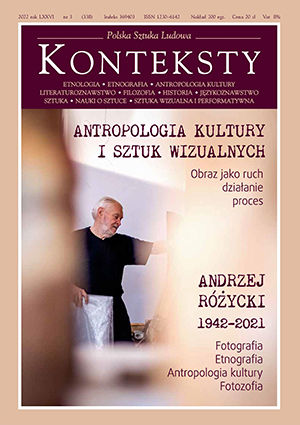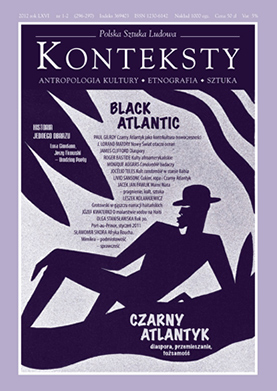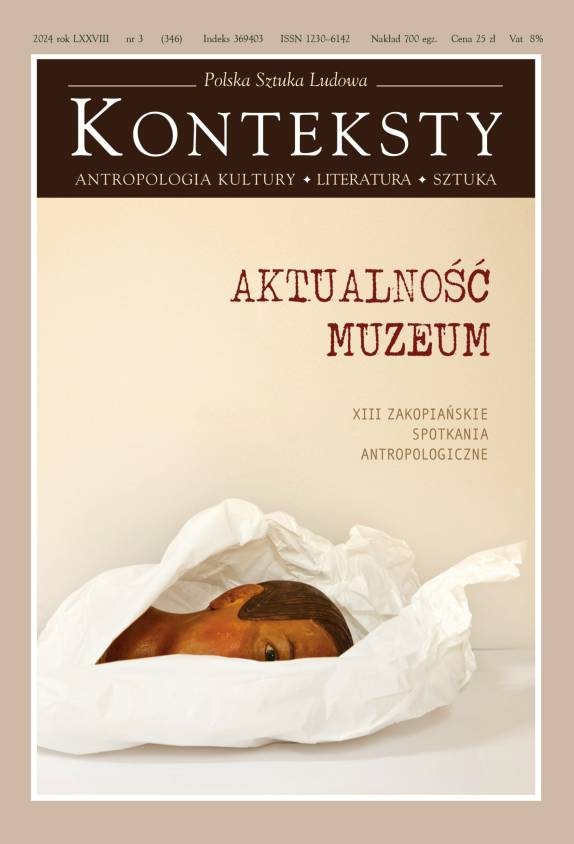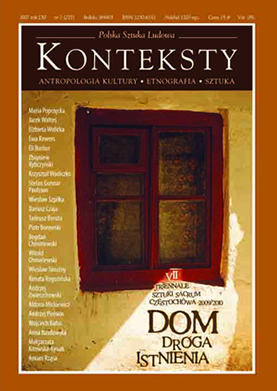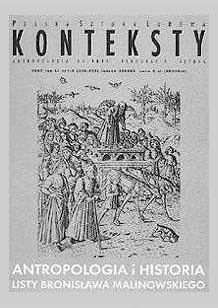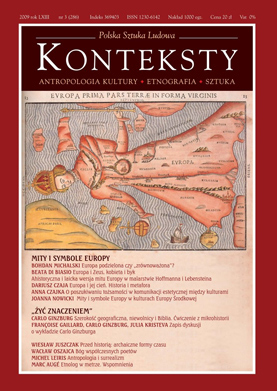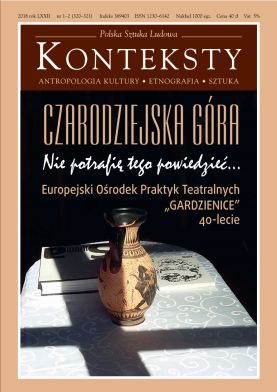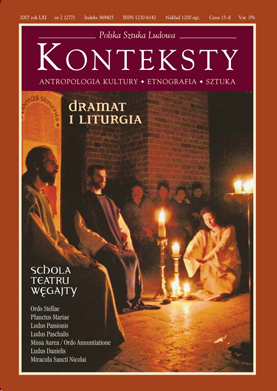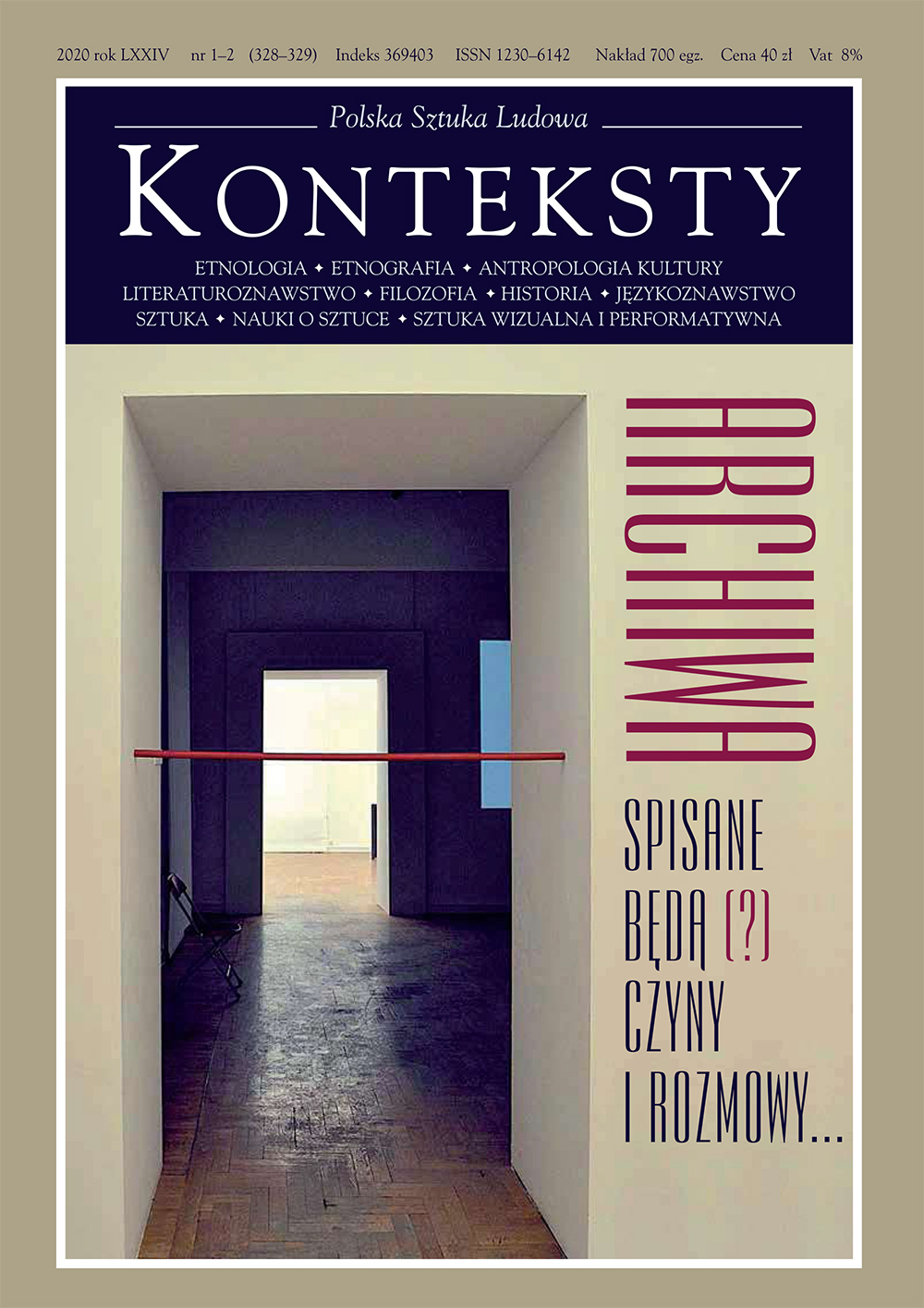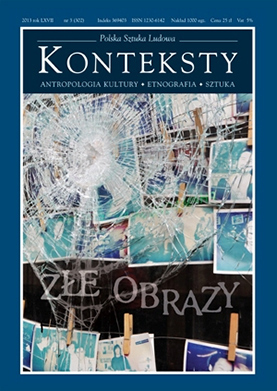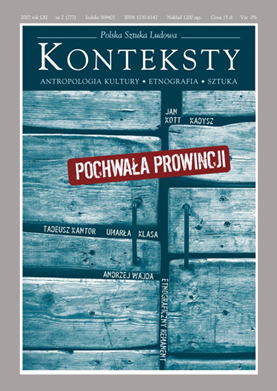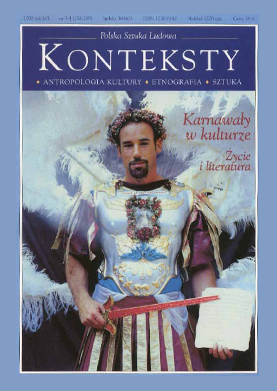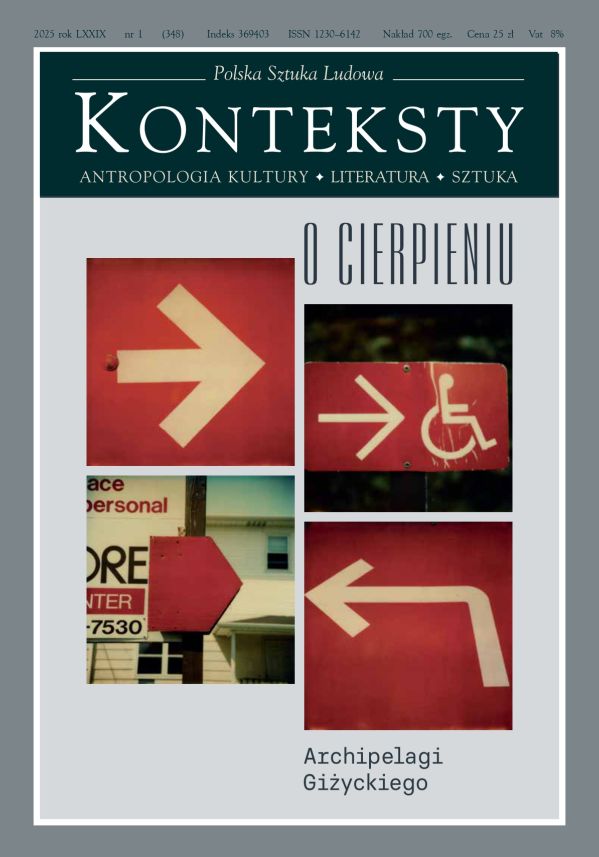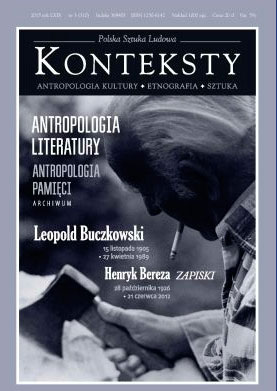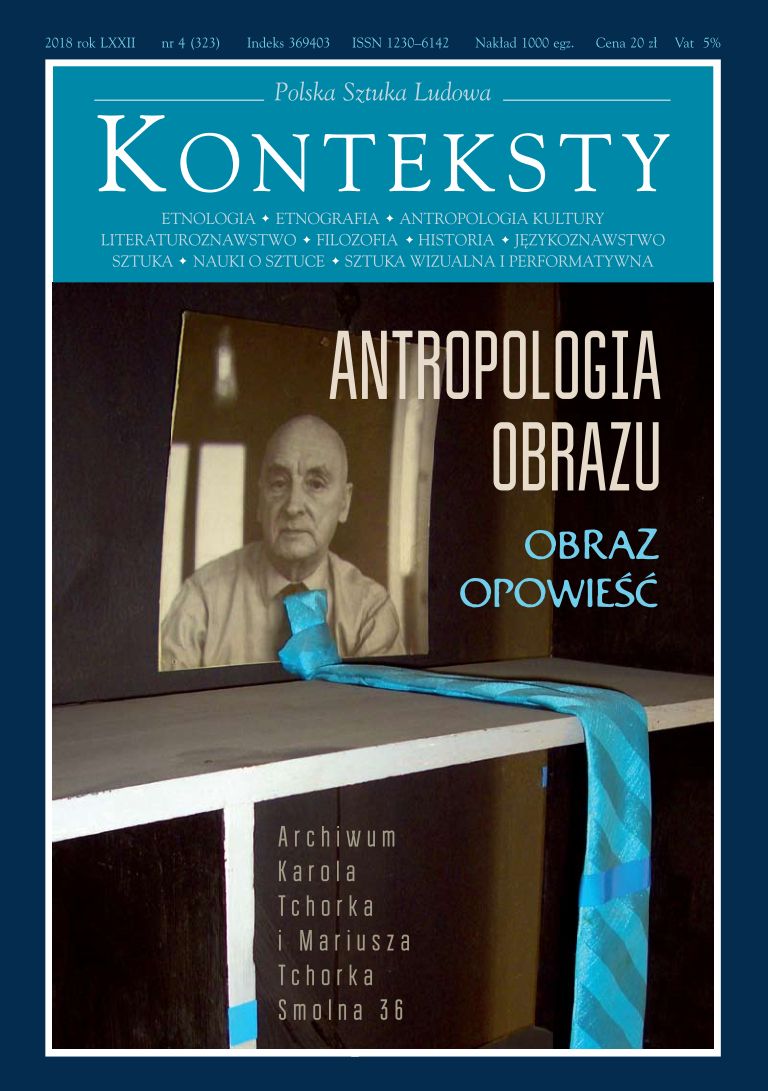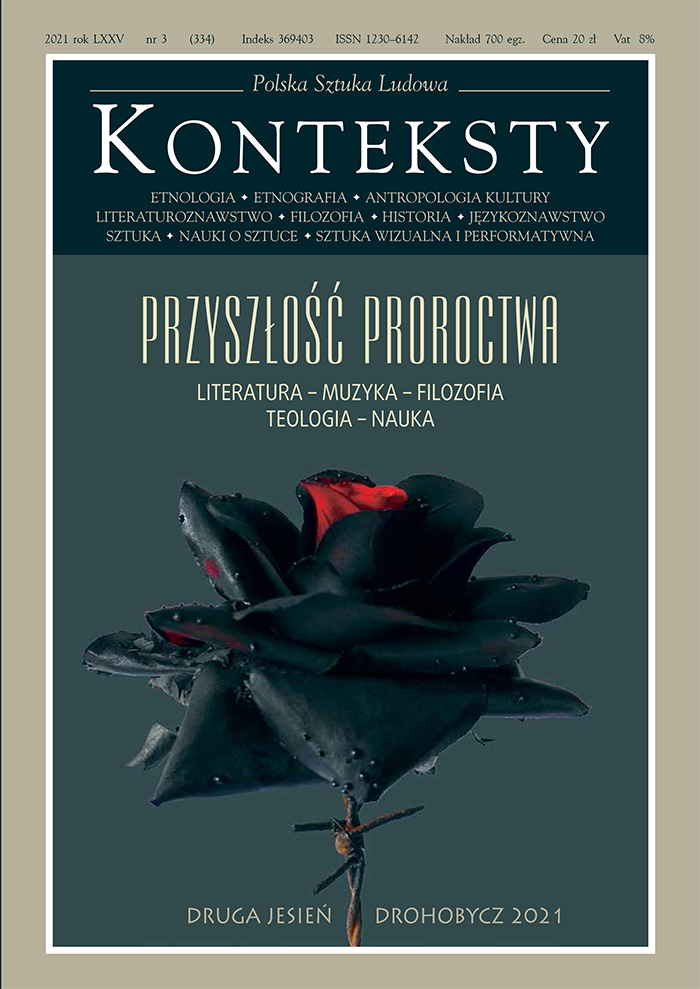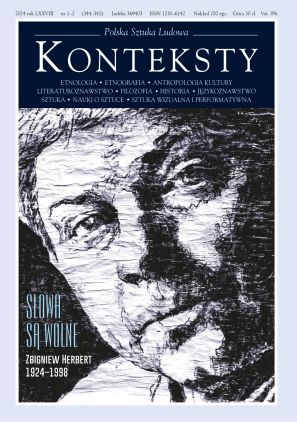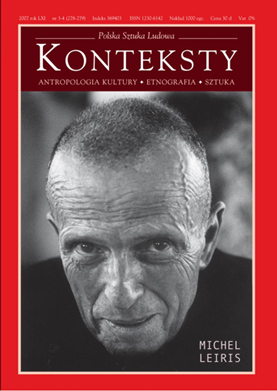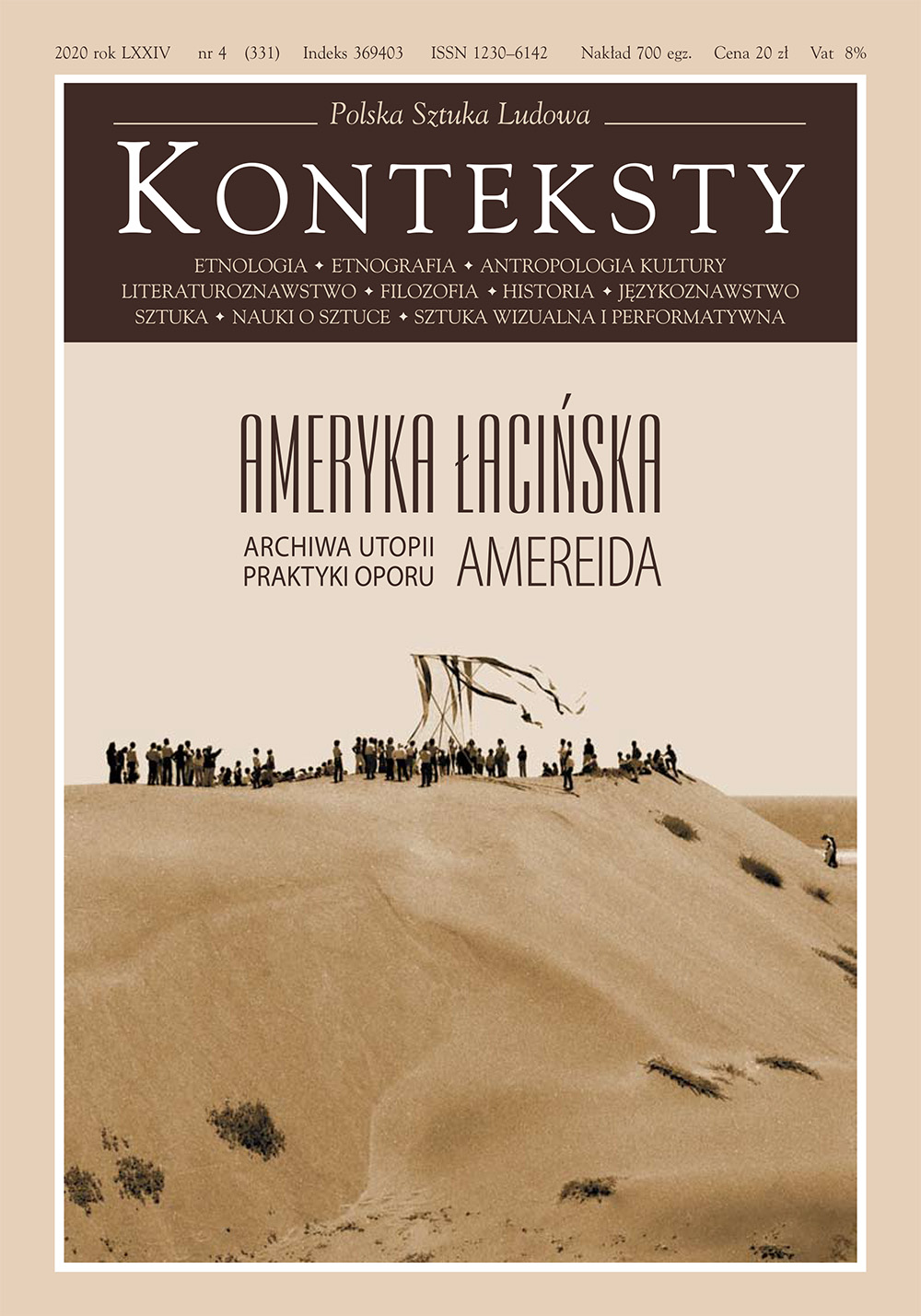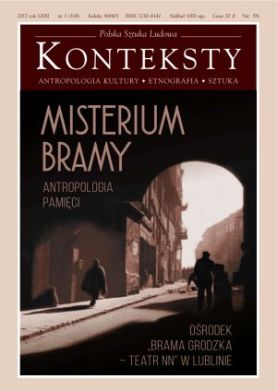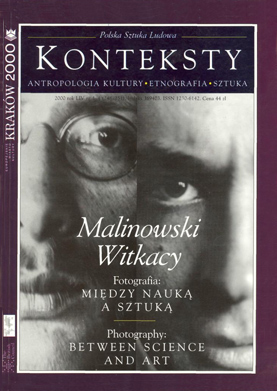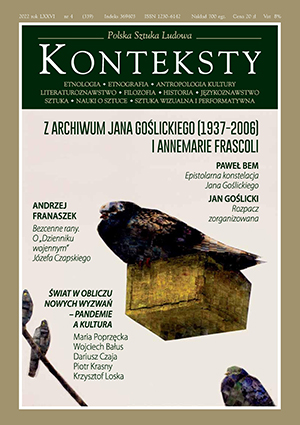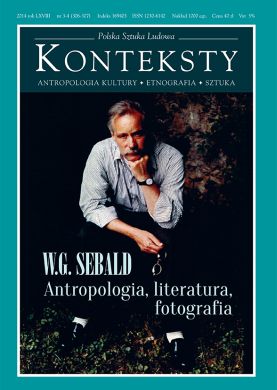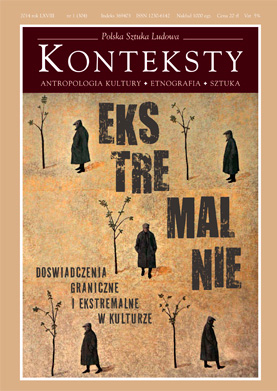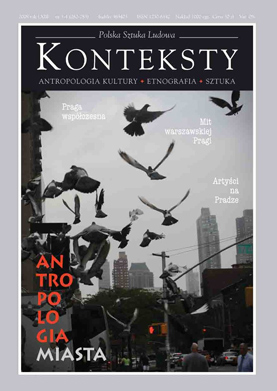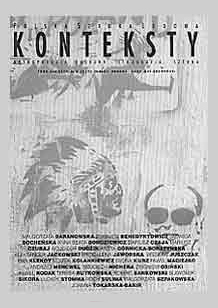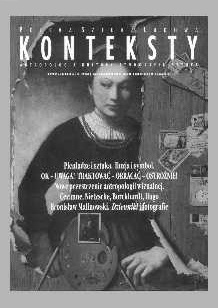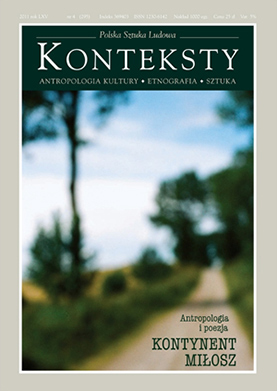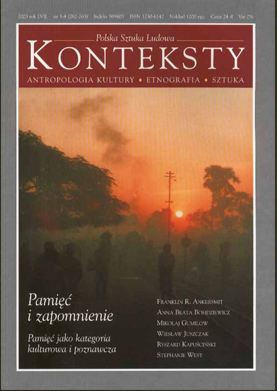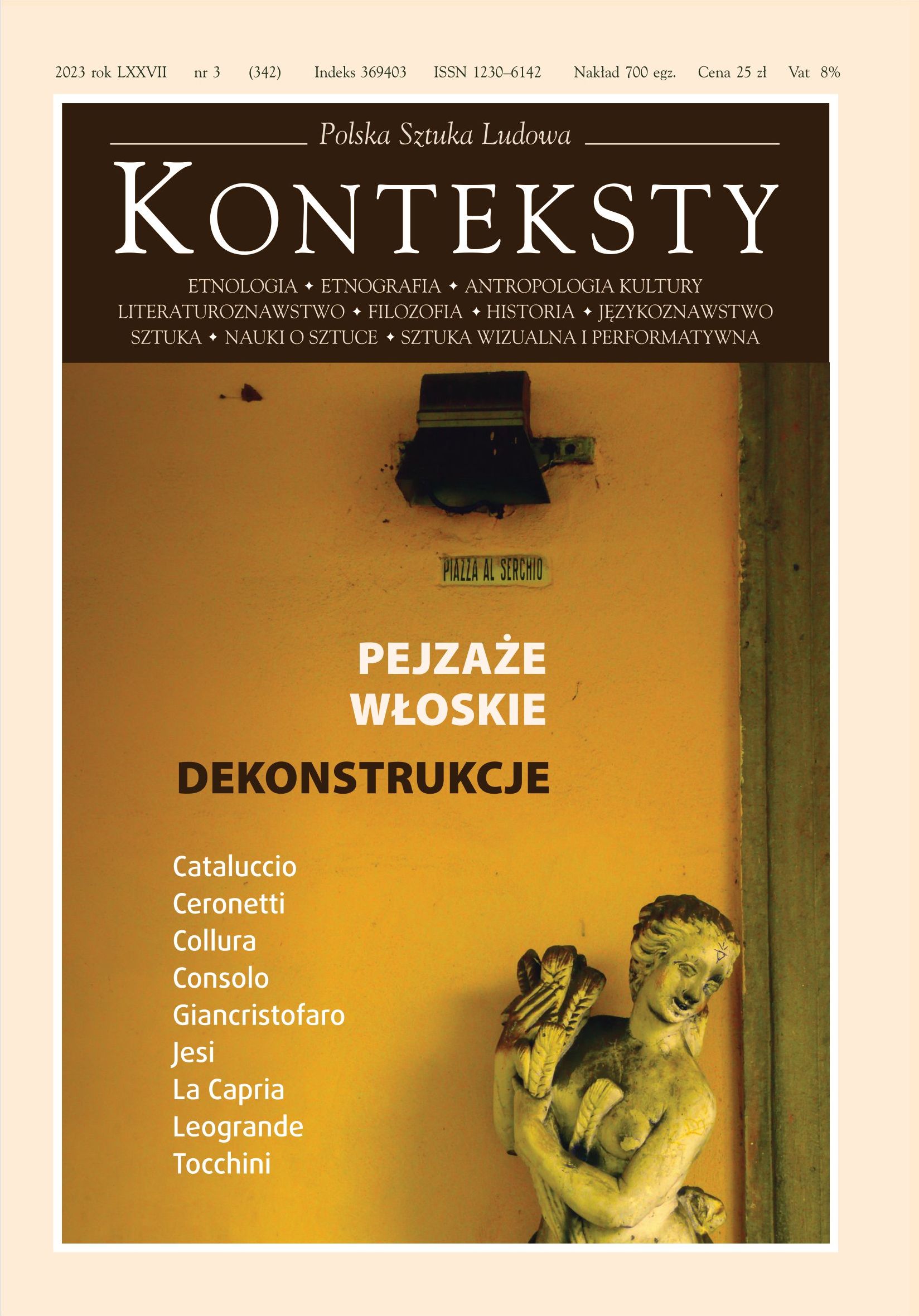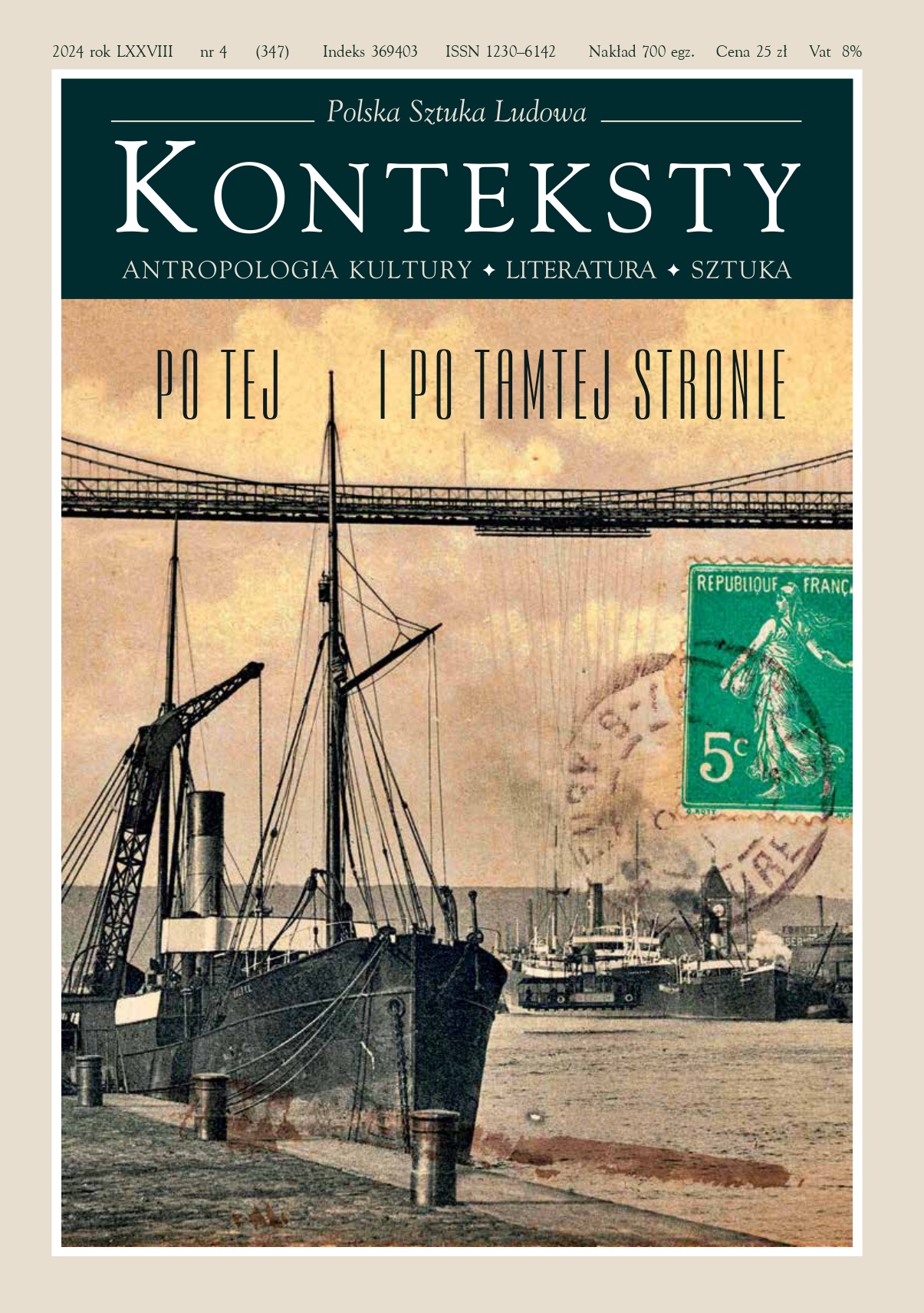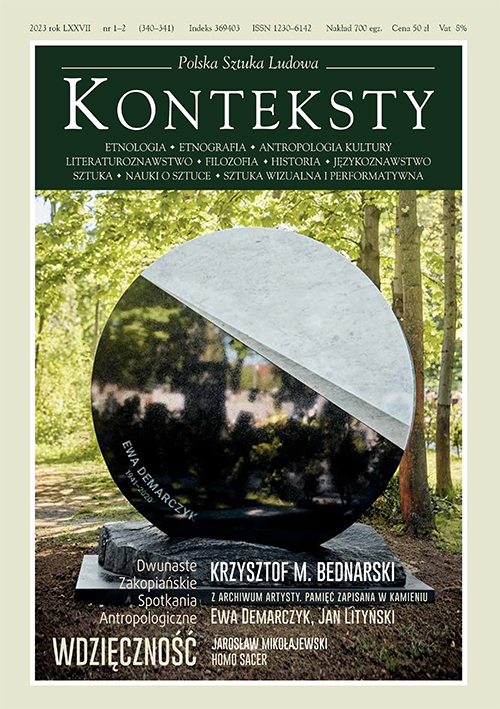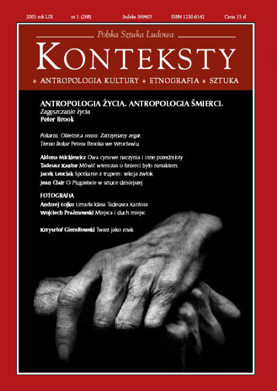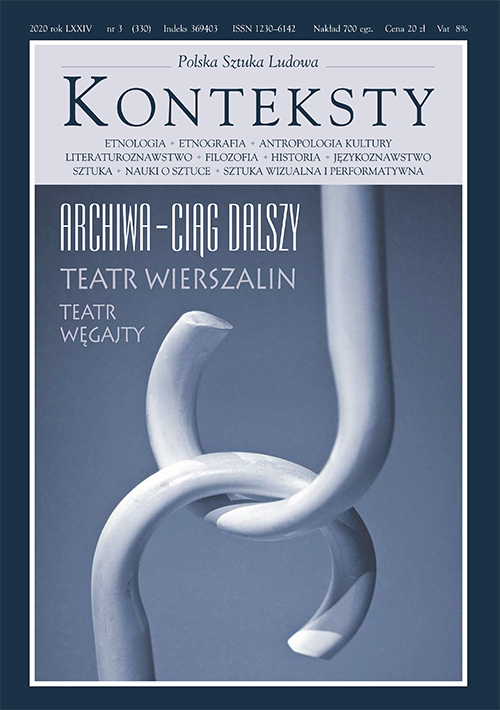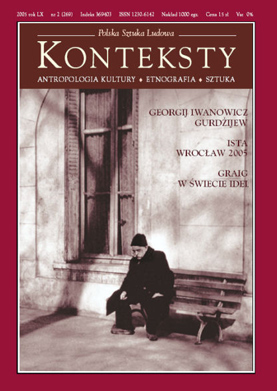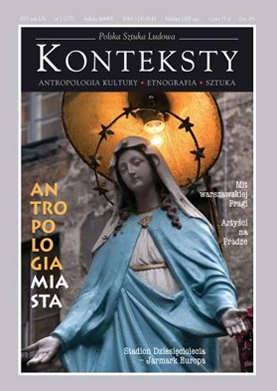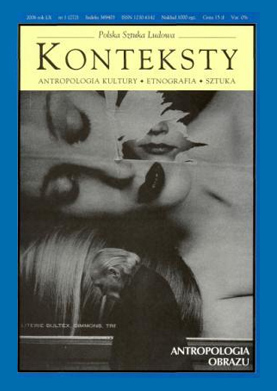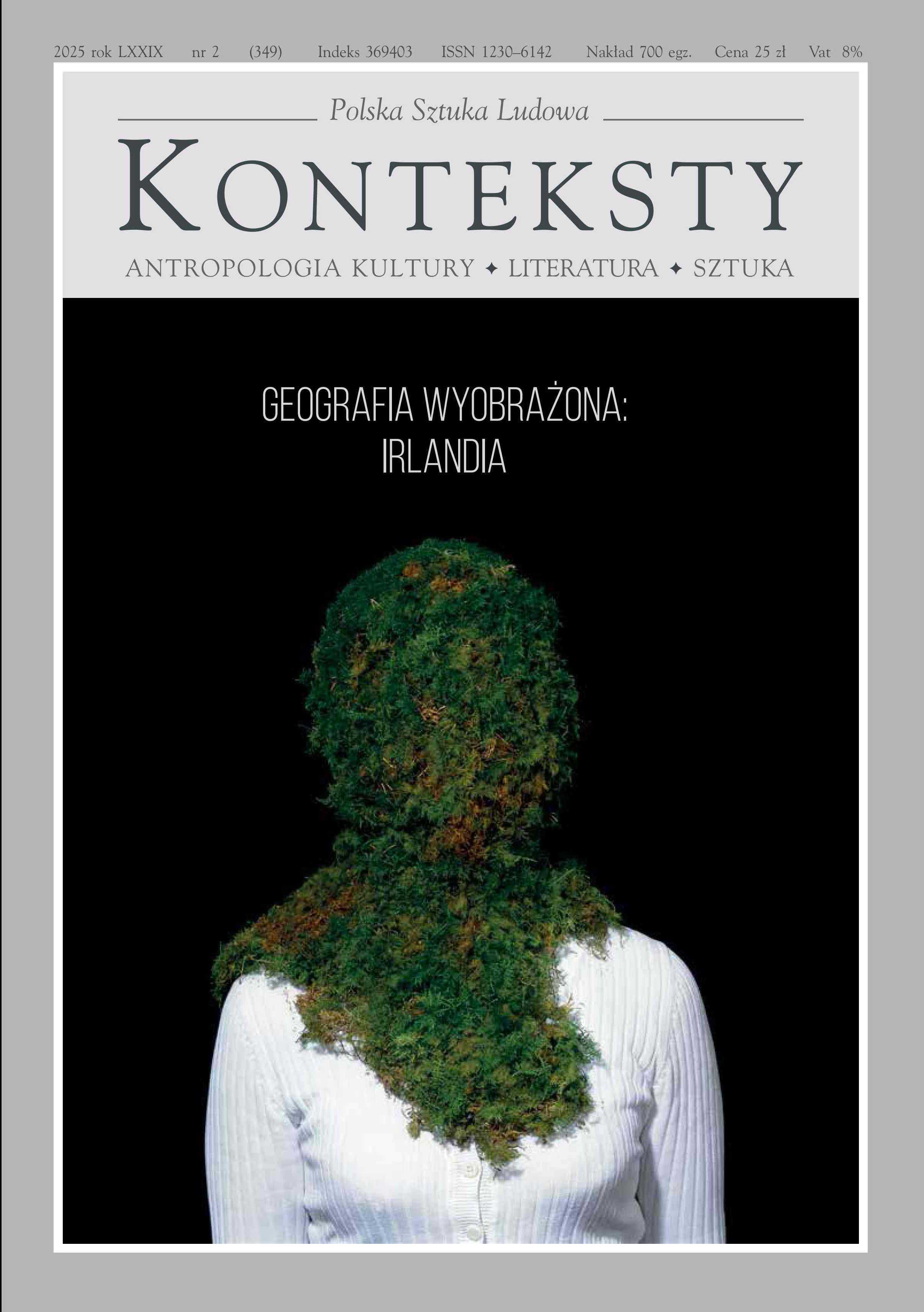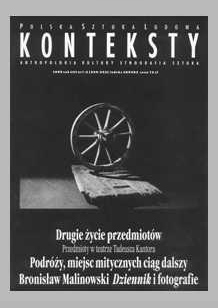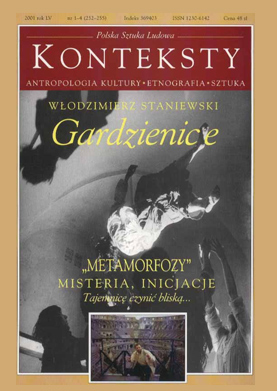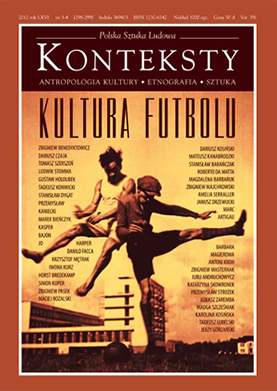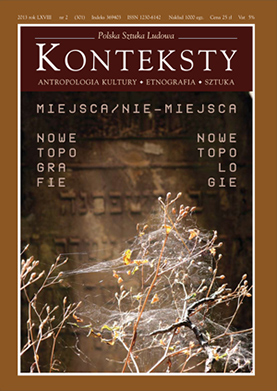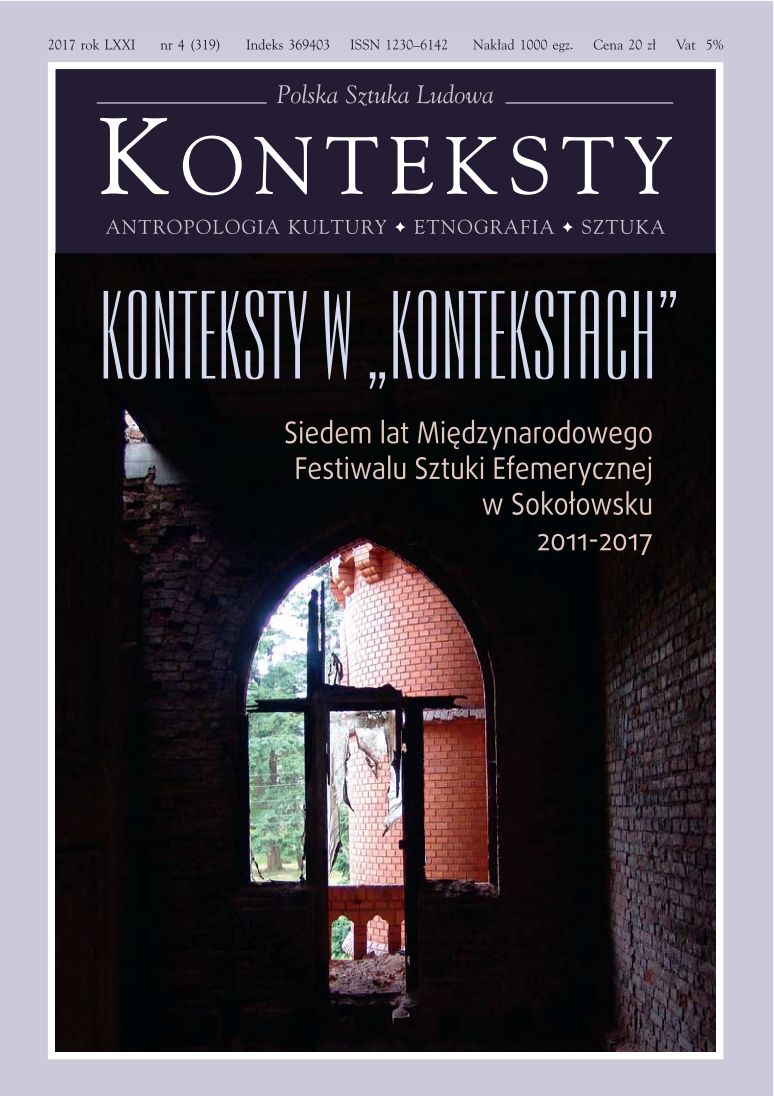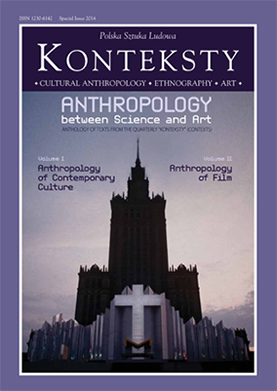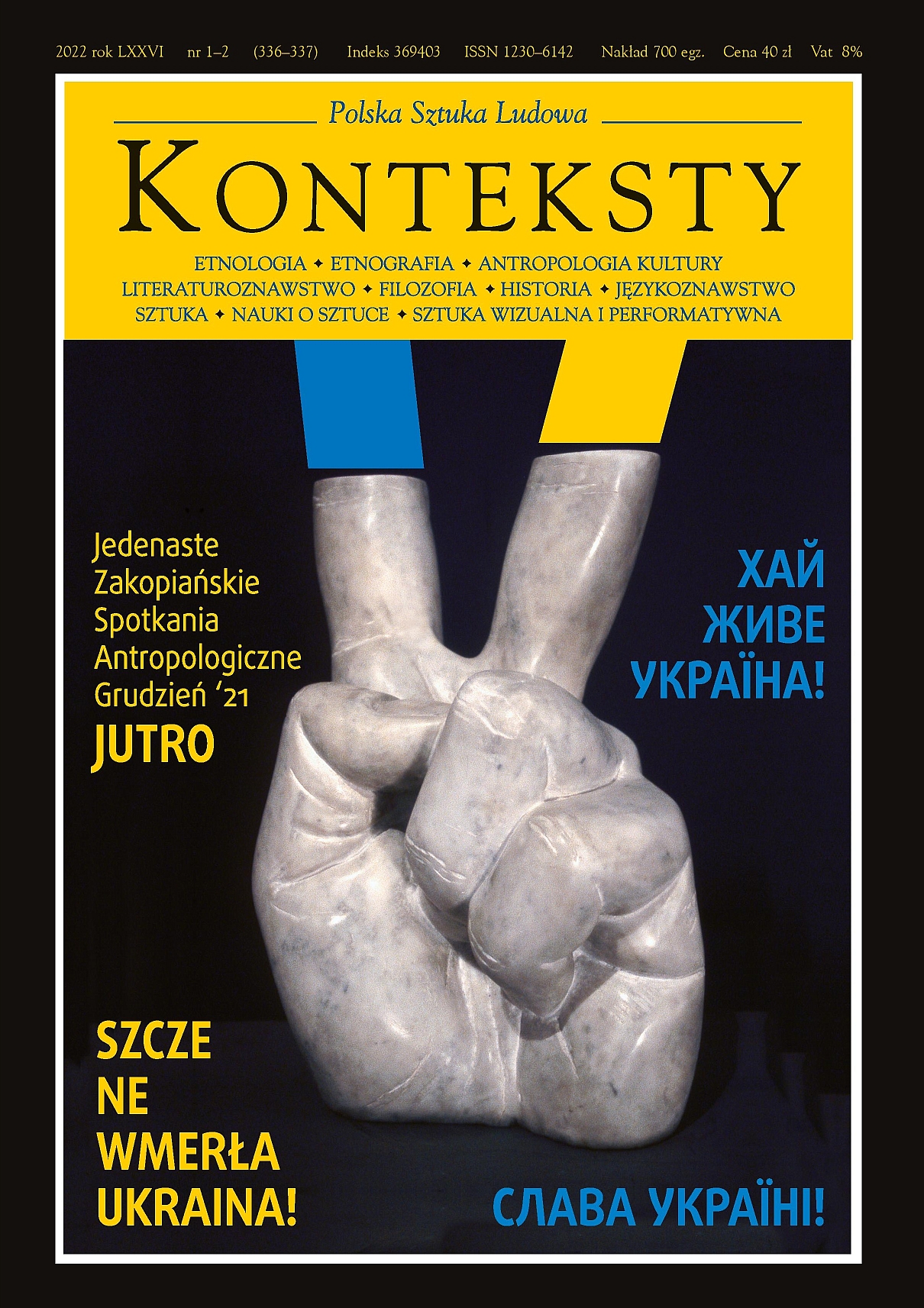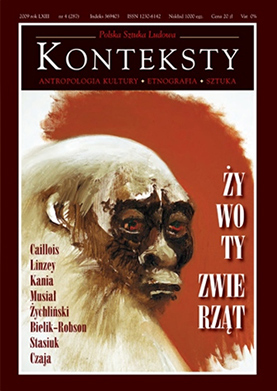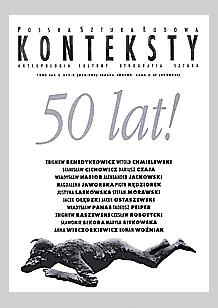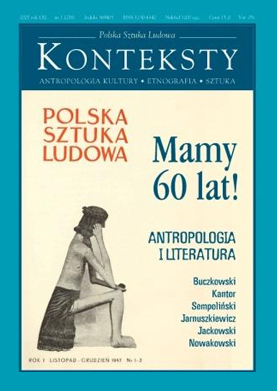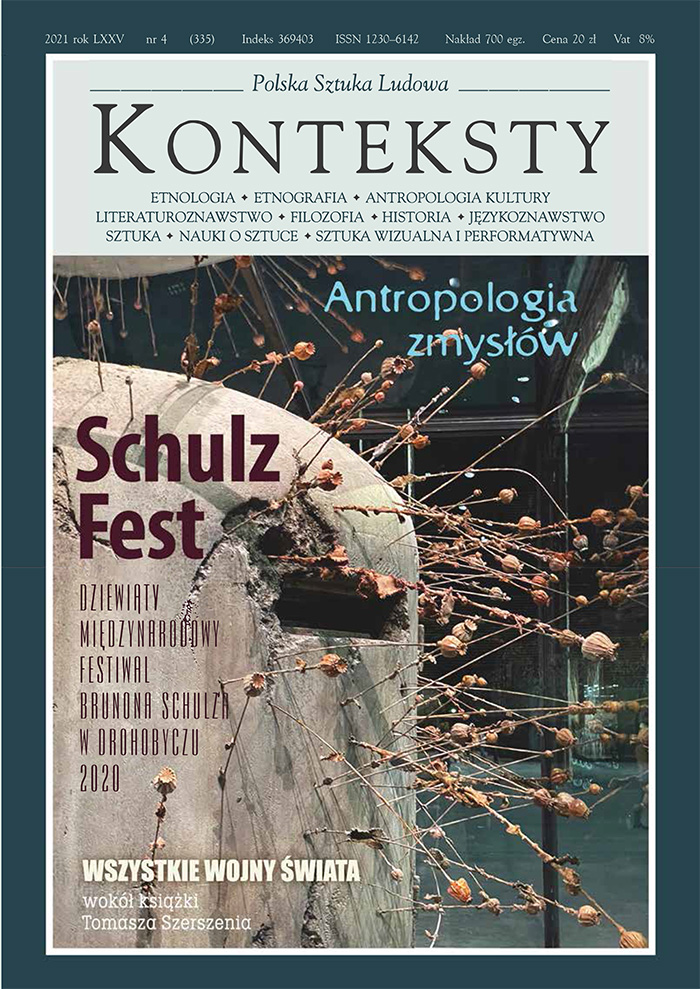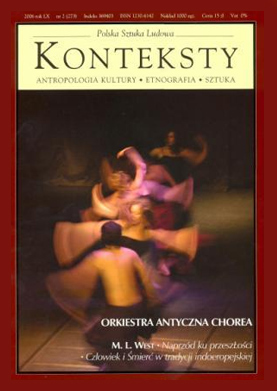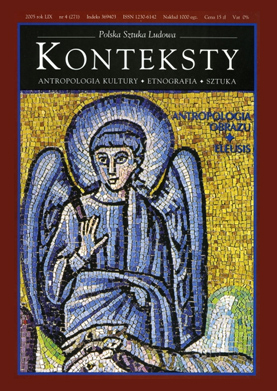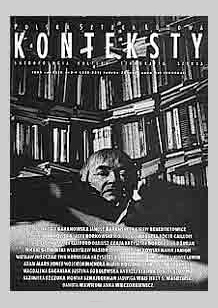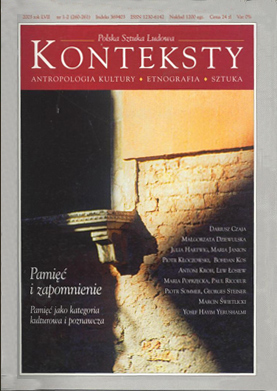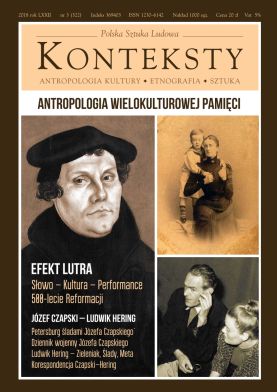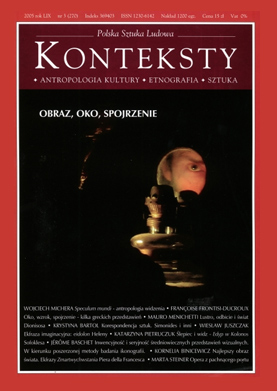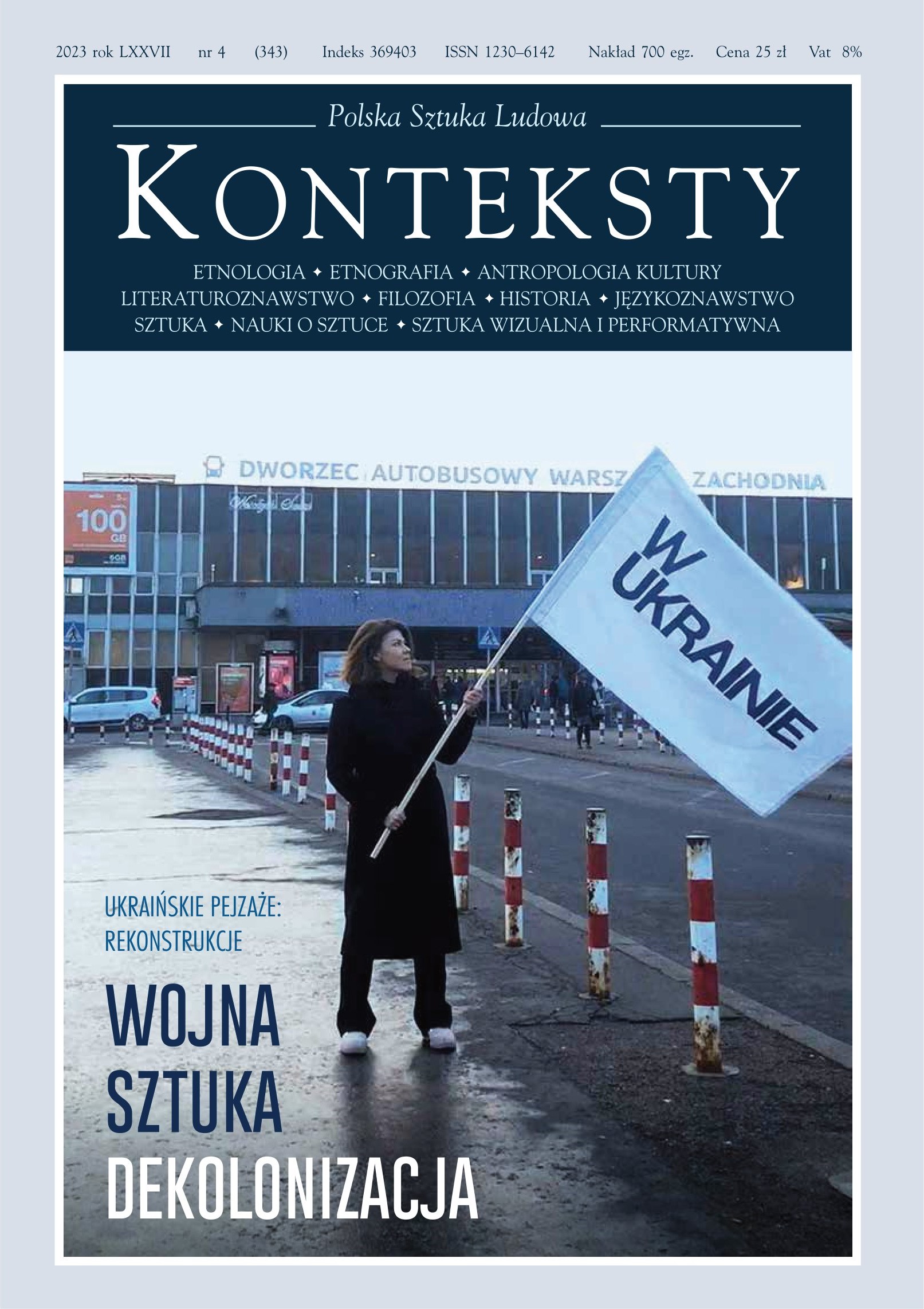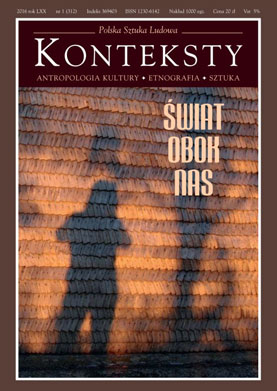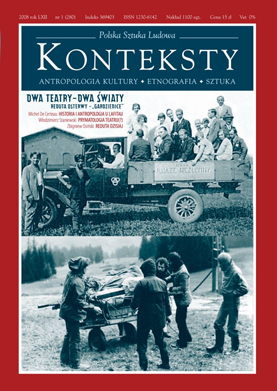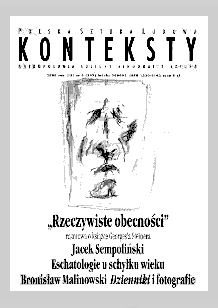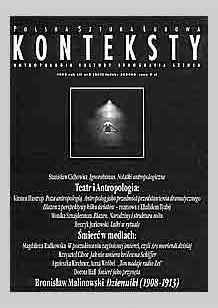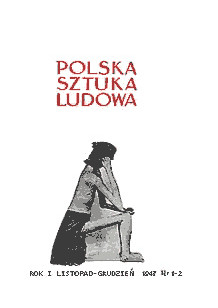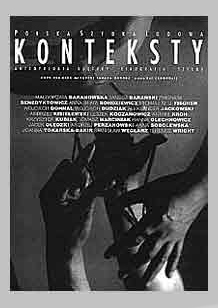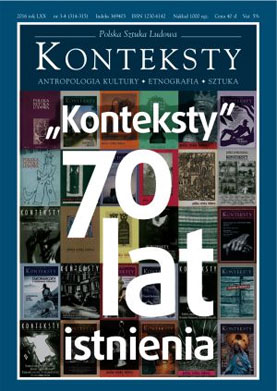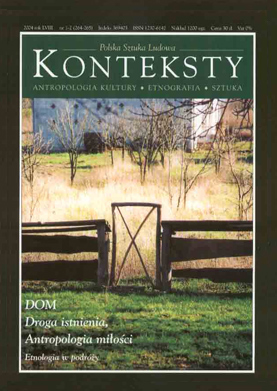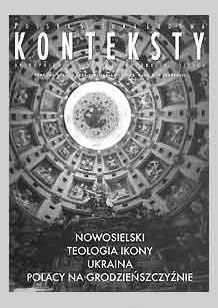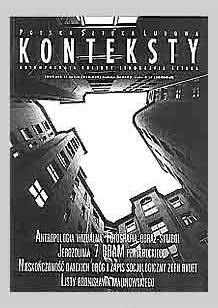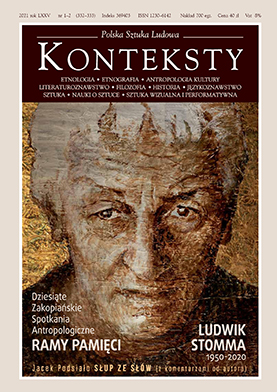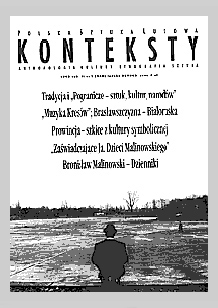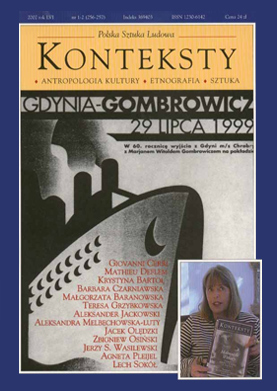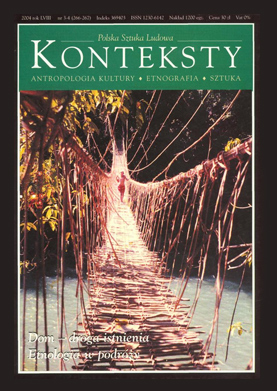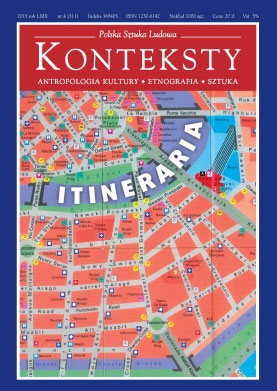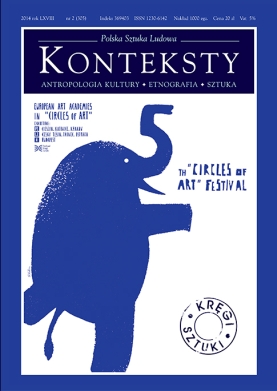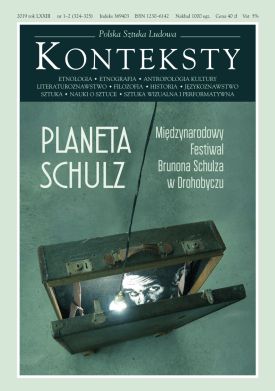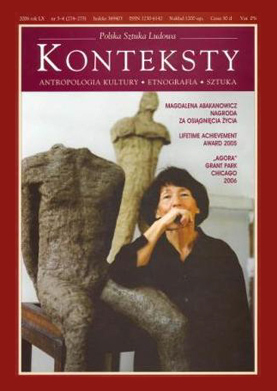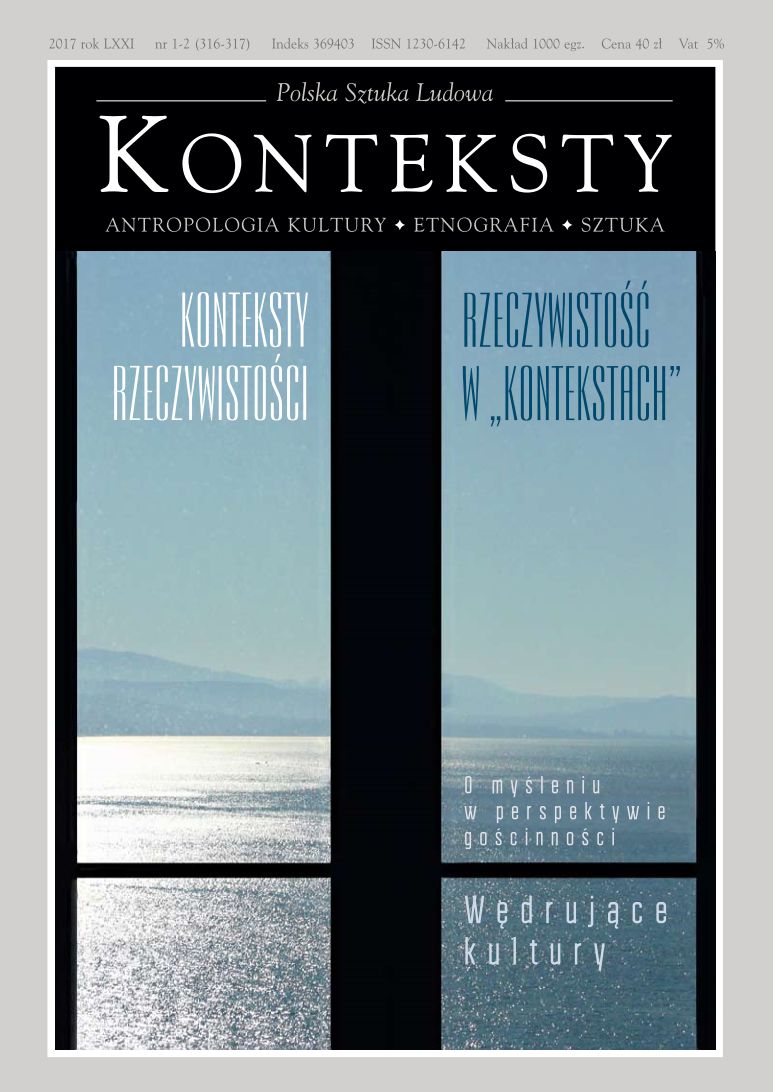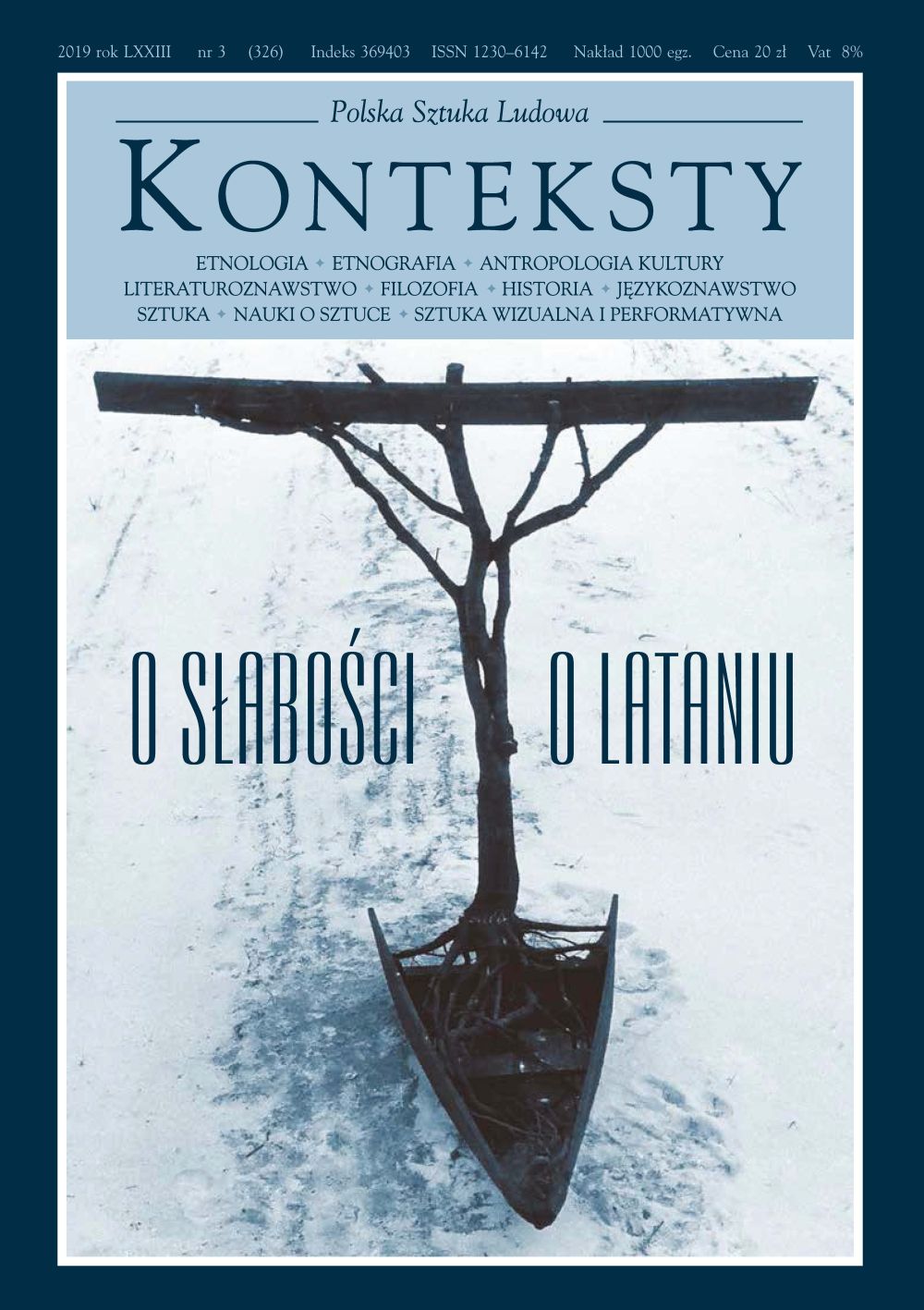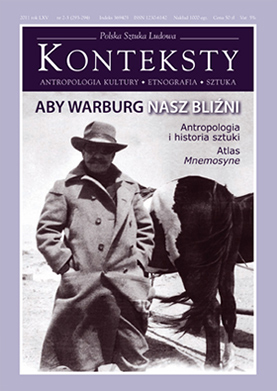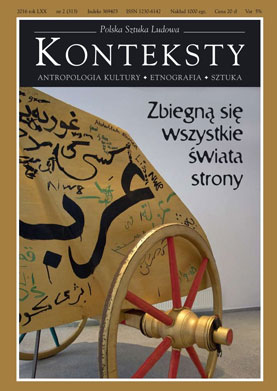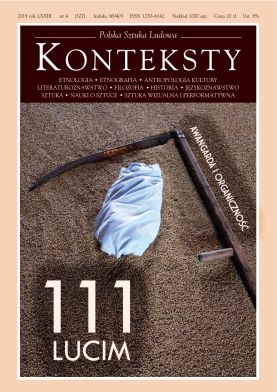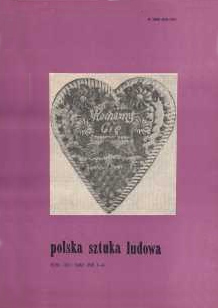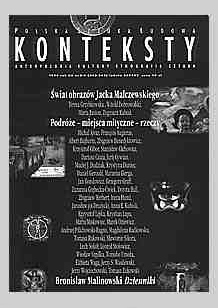Issue 2015/1-2 (308-309) -
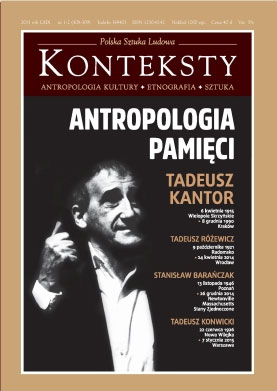
| Wielopole Skrzyńskie – in the Footsteps of Tadeusz Kantor a Hundred Years Later | ||
| Zbigniew Benedyktowicz | Memory – Things, People, and Places  | 4 |
The spectacle Wielopole, Wielopole was shown on 15 December 1983 in Kantor’s birthplace – Wielopole Skrzyńskie - by the Rzeczypospolitej Theatre as part of guest performances given in Cracow, Rzeszów, and Warsaw. This event, which took place soon after the formal end of the martial law period albeit still in the atmosphere created by the latter, gathered local residents, journalists, Polish and French critics, as well as Church and local authorities. The documents of the performance – in the form a film record, reviews, and documentary films - complicate the already complex image of Wielopole, Wielopole against the background of Kantor’s creative biography, multiplying ambiguities and paradoxes in a tangle of political, social, artistic, and media reality. how many images of Wielopole are concealed within this multiplication? how is one to understand the creation of the family myth in the Tadeusz Kantor oeuvreand its transposition? The author depicts the structure of this issue of “Konteksty” commemorating Tadeusz Kantor upon the hundredth anniversary of his birth as the outcome of field research and courses realised in cooperation with the Institute of Ethnology and Anthropology at the University of Warsaw, the Institute of Art at the Polish Academy of Sciences, the editorial board of the quarterly “Konteksty”, the Zbigniew Raszewski Theatre Institute in Warsaw, the Centre for the Documentation of the Art of Tadeusz Kantor Cricoteka in Cracow, the Centre for Documentation and the Museum of the history of the Region – the Tadeusz Kantor Museum in Wielopole Skrzyńskie, and the Society of Friends of the Region of Wielopole. The presented issue of “Konteksty” will focus on “the anthropology of memory”, the cultural dimensions of memory, as well as its significance vis a vishistory and in reference to the discourse and reflections of the humanities in recent decades; it also contains chapters dealing with outstanding authors of post-war Polish culture who died in 2014 and 2015 – the poets Stanisław Barańczak and Tadeusz Różewicz, and the man of letters and film director Tadeusz Konwicki, all of whom regarded the topic of memory as extremely essential. | ||
| Józef Chrobak | Biography of Tadeusz Kantor 1915-1990 | 7 |
| Tadeusz Kantor | "Why Are You Painting Me?" Speech Given at the Congress of Polish Culture on 12 December 1980 | 13 |
| Małgorzata Dziewulska | My History is Many Histories  | 19 |
The author presents micro-histories concentrated on people and marginal objects originating from stories by the inhabitants of Wielopole Skrzyńskie. The local nature of the history of ”lesser events” suggests the concrete, which protects against abstraction and an excess of symbolisation. The approach proposed by micro-history, and its desire to render indelible the unknown dimension of selective knowledge, intentionally chooses fragmentariness and intermittence. | ||
| Józef Chrobak | Wielopole and "Wielopole" by Tadeusz Kantor  | 30 |
Selected reviews and descriptions of the play (1983-1984). | ||
| Zbigniew Benedyktowicz | Notes from a Successful Retreat in Wielopole Skrzyńskie | 36 |
| N. N. | ”The grey infantry is marching… with death hurled at their feet”. Selected reviews and descriptions 1983-1984 | 39 |
| Maria Wójcik | Blurred Traces  | 47 |
Recollections of a custodian of the Centre for Documentation and Museum of the history of the Region – the Tadeusz Kantor Museum in Wielopole Skrzyńskie. | ||
| N. N. | Excerpts from Conversations and Interviews – Wielopole Skrzyńskie, Brzeziny, 2014 | 51 |
| Eliza Siulborska | The Blouse as a Memory Carrier  | 54 |
Storing and collecting pertain to objects-souvenirs of assorted orders connected wuth memory, the past, the family home, botanical, natural and artistic objects and even daily use items, including clothes. The amassed objects may enable us to find out what is important for man and worthy of commemoration, and become a source of knowledge about him. | ||
| Tadeusz Kantor in Tarnów and the Occupation in Cracow | ||
| Zbigniew Benedyktowicz, Dorota Krakowska | On the Exhibition: "We Were. About The Dead Class" by Tadeusz Kantor in Tarnów and "Memory Sketches" – a Record of a Conversation  | 60 |
The conversation focuses on assisted issues associated with the exhibition "We Were", co-organised by the interlocutor (Tadeusz Kantor’s daughter) at an art gallery in Tarnów – the town where her father attended secondary school. With the assistance of photographs the exhibition portrays the void left by the large local Jewish community. | ||
| Ewa Krakowska | "Sketches from Memory": the Occupation  | 67 |
A chapter from the book: "Szkice z pamięci" by Ewa Krakowska, first wife of Tadeusz Kantor, presenting life in Cracow during the German occupation, the beginnings of her marriage to Kantor, and the Underground Theatre. A fragment of a portrait of the Cracow artistic milieu of the 1940s. | ||
| Wawrzyniec Brzozowski | "Powrót Odysa". On Tadeusz Brzozowski in Kantors Theatre  | 71 |
The author of this text, the son of the acclaimed painter Tadeusz Brzozowski, actor in the underground Kantor Theatre, tells about his father while using preserved documents and reminiscences of members of the family and friends, and, predominantly, his own. A presentation of a rather littleknown episode in the biography of Tadeusz Brzozowski who acted in the Kantor Theatre in Cracow at the time of World War II in „Balladyna” (premiere in 1943 in a private home) and was the lead character in „Powrót Odysa” („The Return of Odysseus”, 1944). he last appeared in „Niegodzien i godni” („The Unworthy and the Worthy”) by Józef Czechowicz, staged by Kantor upon the occasion of the inauguration of the “Rotunda” Academic Youth Theatre in Cracow. | ||
| Marta Kufel | Recurring “Towns of Death”  | 79 |
This text evokes the school bench from „The Dead Class” by referring it directly to the Holocaust of the Jewish pupils of the secondary school in Tarnów, attended by Tadeusz Kantor. It also discloses similarity to a vision in a story by Jan Bielatowicz, another graduate of this school. The author interprets Kantor’s object via an impasse in the representation of the “absence of the absent”, with the saved depicted as the accused. Following this approach, the author initially outlines within Kantor’soeuvrea map of the “towns of death” connected with the Holocaust. | ||
| Małgorzata Maj, Stanisława Trebunia-Staszel | On Tadeusz Kantor, Ethnographic Draughtsman, and the Photographs of Wielopole Skrzyńskie Preserved in the IDO Archive  | 81 |
The text discusses an episode from the time of the German occupation when Tadeusz Kantor was employed for several months as a draughtsman in Sektion Rassenund-Volkstumsforschung (Section for Race and National Tradition Research) of Institut für Deutsche Ostarbeit (Eastern Research Institute – IDO), established by the Germans in Cracow in April 1940. Since this fact has been merely mentioned in the Artist’s biographies the authors attempted to add information found in German and Polish documents concerning the work performed by IDO. In doing so, they drew attention also to unpublished archival photographs taken in July 1942 in Wielopole Skrzyńskie and Glinik, which despite the fact that they originate from Propaganda-Amt could have something in common with on-the-spot research conducted by Sektion Rassen- und Volsktumsforschung. | ||
| Lovelies and Dowdies and The Dead Class | ||
| Małgorzata Maj | How I “Played” in Lovelies and Dowdies – Recollections after Forty Years  | 88 |
Reminiscences of a staging of „Nadobnisie i koczkodany” („Dainty Shapes and Hairy Apes, or The Green Pill: A Comedy with Corpses”), directed by Kantor at the Krzysztofory Palace in Cracow in 1973. | ||
| Maria Stangret | Lovelies and Dowdies and The Dead Class  | 89 |
Reminiscences by an actress of Tadeusz Kantor’s Cricot 2 Theatre (and in private life - his wife). A description of the rehearsals of Witkacy’s „Dainty Shapes and Hairy Apes, or The Green Pill: A Comedy with Corpses”, whose premiere took place in May 1973 at the Krzysztofory Palace, as well as backstage preparations for „The Dead Class”, a spectacle that produced euphoria and enthusiasm among the theatrical milieu. | ||
| Return to Wielopole | ||
| Joanna Jopek | Microhistories of Wielopole and "Wielopole"  | 95 |
The establishment of a hierarchy of importance and the selection of a viewpoint from which a story is told are crucial and undeniable for the work performed by an historian: he creates narration in which subjective cultural presuppositions and narration models, often ignored by historians, are just as important as facts. An historical fact is an event distinguished from the past and inscribed into the framework of the story; history is a staging of such facts and for this reason the historian’s task does not entail an objective presentation of events from the pasts since its very foundation includes creation and the subjective nature of the choices made by historians as well as the sui generisperformativeness of memory. | ||
| Dawid Mlekicki | Holy Invisibility  | 101 |
An attempt at a reportage interpretation of the author’s first stay in Wielopole Skrzyńskie. The text is an appendix to research on the medial image of the Cricot 2 Theatre at the time of the presentations of "Wielopole, Wielopole" in Poland in 1983. The form of an account of a one-day stay in Wielopole Skrzyńskie attempts to use a reportage as a meta-commentary pertaining to a unique encounter with a historical fact, an artistic event, and medial mediation, i.e. the staging of "Wielopole, Wielopole" in Kantor‘s hometown on 15 December 1983. | ||
| Dawid Mlekicki | ‘Wielopole, Wielopole’ by Tadeusz Kantor Shown in the Parish Church in Wielopole Skrzyńskie. The Medial Image of the Event  | 105 |
The text concentrates on the motif of a “media scandal” caused by a presentation of the spectacle Wielopole, Wielopolein the hometown of Tadeusz Kantor in December 1983. By evoking selected fragments from the staging of this play at the time of the Polish tournées in 1980 and 1983 the author outlined the intriguing background of the presentation composed of non-obvious correlations of medial, political, artistic, and local reality. In a wider context the analysis pertains to the complex structure of the spectacle’s language, with due attention paid to the changes that the production underwent from the time of its premiere to its final presentation as well as the context accompanying its staging in Poland in 1980 and 1983. This text attempts to prove that heretofore unexamined contexts and the absence of a sufficiently critical and competent examination of the participation of medial mediation in the creative biography of the Artist have produced a unique manipulation, whose effects are present in the reception of the Kantor oeuvre up to this day. | ||
| Wielopole Stories | ||
| Jagoda Gutowska | A Renaissance Man from Wielopole  | 138 |
Roman Lipa – artist, craftsman and local patriot from Wielopole – executed over a hundred canvases, wrote several biographical-historical books, and initiated a number of local undertakings. The article is based on reminiscences shared by his daughter, halina Brzoza, and granddaughter, Barbara Lipa. | ||
| Roman Lipa | Fragments of the History of Wielopole Skrzyńskie  | 141 |
Roman Lipa from Wielopole is a true “Renaissance man” – photographer, painter, and amateur historian. The article is composed of selected fragments pertaining to the history of the school in Wielopole and the local fire brigade, as well as a description of a tragic fire of the cinema in Wielopole. The last text by Lipa is about Prelate Julian Śmietana and his activity in Wielopole from the first years spent as a parish pries, the wartime and post-war period, to 1985, when Tadeusz Kantor staged his Wielopole, Wielopole in Wielopole. | ||
| Marcin Krassowski | Second Autumn. Collections from the Region of Wielopole Skrzyńskie  | 148 |
This article is the outcome of on-the-spot studies concerning museums and collections in the environs of Wielopole – the birthplace of Tadeusz Kantor. The first part of the text is a brief description of seven collections, while the second contains reflections inspired by the philosophical deliberations of Manfred Sommer about the possibility of discovering the specificity of syncretic collections, an analysis of objects from their initial scattering to gathering them in a collection, and, finally, the significance of a local collection in the region and for its sake. | ||
| Roman Lipa | Extermination of Jews in Wielopole  | 158 |
The author – a chronicler of Wielopole Skrzyńskie – described the tragic extermination of the Jews of Wielopole in June 1942. | ||
| Aleksandra Domaradzka | Dear Departed. Memory about Tadeusz Kantor and the Jews of Wielopole Skrzyńskie  | 160 |
A presentation of links between memories about Tadeusz Kantor and the Jews of Wielopole Skrzyńskie. A pretext for the reflections was the staging in Wielopole of Kantor’s spectacle: "Wielopole, Wielopole" and the reactions it produced. The reception of the play reflects the attitude of the inhabitants of Wielopole both towards Kantor and the pre-war Jewish community. | ||
| Urszula Klimut | Places of Degraded Concepts in Local and Institutional Memory. On Tadeusz Kantor in Wielopole Skrzyńskie  | 163 |
The protagonists of this article: chest, a suitcase, a cross, a chair, a kerosene lamp, a teacup, and a photograph play a prominent part in commemorating Tadeusz Kantor in Wielopole Skrzyńskie. Although they have nothing in common with the artist and do not possess historical or aesthetic merits they became exhibits displayed in a museum and, subsequently, a memory chamber dedicated to Tadeusz Maria Kantor in the Wielopole secondary school. The process of capturing their ambiguous and changing status is assisted by the category of the “poor object” derived from the Kantor theatre, which renders their presence in a museum celebrating the artist an extremely ironic coincidence. The “poverty” of objects, revealed contrary to the intentions of the authors of the exhibition, became the lead protagonist in the creation of institutional memory about Kantor. | ||
| Rafał Rukat, Urszula Klimut | The Degraded Tradition of Wielopole Guilds  | 171 |
The article is about about artisan guilds active in Wielopole Skrzyńskie (officially to 2006) as an example of tradition to a considerable extent ousted from the social memory of the inhabitants. The authors present the information they managed to collect as well as the process of reaching sources, with a special role played by materiality – both the one, which the ethnographers encountered directly and the one, which left its imprint on the memory of their interlocutors. Finally, the authors attempted to determine the causes of the decline of the guild tradition and to explain the reasons why it was not recognised by the residents of Wielopole as one the local cultural highlights worthy of commemoration, such as: the so-called Turki and Meus rituals, the drum of King Sobieski or Tadeusz Kantor. In doing so, they also indicated the important role performed by this oblivion in the identity of those who remember. | ||
| Katarzyna Flader-Rzeszowska | Border-like Objects in the Tadeusz Kantor Death Theatre  | 178 |
The article discusses the border-like object in the theatrical world of Tadeusz Kantor while going on the assumption that such objects divided the world into two spaces and are situated between reality and the imagination. They include funereal objects that conceal and camouflage death and tell about life after death as well as semiotically ambiguous objects possessing an obverse and a reverse. By applying the reflections of anthropologists of death and the image – Jean-Didier Urbain, hans Belting or Alfons di Noli – the author evoked examples of such objects and their role in the Theatre of Love and Death. Among Kantor’s border-like objects (door, window, photograph, ladder, grave, and coffin) the grave, conceived as the artist’s most representative object, and the window, envisaged as a medial one, were selected for particular analysis. The presented reflections demonstrate that in Kantor’s theatre border-like objects deprived death of its power to destroy the continuum and granted a conviction that there exists another side of reality by becoming a visible sign of life after death. In doing so, they provided a feeling of creating eternity in mortality. | ||
| Tadeusz Kantor in England | ||
| George M. Hyde | A Lecturer Joins a Long Procession  | 187 |
The People’s Republic of Poland and Polish cultural life of the period from the vantage point of an Englishman – recollections of a three year long stay in Lublin in the second half of the 1970s. The essay was included in the book: "Cold War, Common Pursuit. British Council Lecturers in Poland, 1938-1998", ed. by Peter J. Conradi, Stoddard Martin, Starhaven 1999. | ||
| George M. Hyde | Death in a Tavern: Tadeusz Kantor and "Wielopole, Wielopole"  | 193 |
An introduction to the English edition of Wielopole, Wielopole (Tadeusz Kantor, Wielopole, Wielopole, ed. by G. M. hyde, trans. by Mariusz Tchorek, London: Marion Boyars, 1990). | ||
| Marcin Krassowski | Everything, but Kępiński – an Interview with Katy Bentall  | 198 |
This interview with Katy Bentall, widow of Mariusz Tchorek, contains several motifs generated by the situation in which the conversation took place, namely, while examining the archive of Mariusz Tchorek, which Katy Bentall created and placed in the former studio of Karol Tchorek, father of Mariusz. Its common axis is a translation of Wielopole, Wielopole, a task that took Mariusz Tchorek almost ten years. One of the discoveries made in Tchorek’s archive is a letter addressed by Tadeusz Kantor to Mariusz Tchorek, in which the former described his first inspirations for creating this particular play. Another essential motif involves the life and works of Mariusz Tchorek, art theoretician, translator, and therapist. | ||
| Tadeusz Kantor in Foksal Street in Warsaw – the Foksal Gallery and the Dziekanka Club | ||
| Ewa Benesz | Zero Regions in the Zero Theatre – Account of a Meeting at the Dziekanka Club  | 207 |
A fragment of a record of a conference and a meeting held by Tadeusz Kantor at the Dziekanka Club in Warsaw in 1969. | ||
| Zbigniew Taranienko | A Meeting with Tadeusz Kantor  | 209 |
A record of a meeting with Tadeusz Kantor on 3 March 1973 in his studio in Elbląska Street (Cracow). | ||
| Wiesław Borowski, Zbigniew Benedyktowicz | “Art is a Special Solution”. On Wielopole and Cooperation with Tadeusz Kantor – a Recorded Conversation  | 217 |
For years Wiesław Borowski assisted Tadeusz Kantor, commenting and popularising his work in Poland and across the world, both during the artist’ lifetime and after his death. Borowski is also the co-author of the idea of establishing the unique Cricoteka centre, which originally was to be situated in Florence and then was created and functioned in Cracow. | ||
| Wiesław Borowski | He and She  | 221 |
Reflections of an art historian, exhibition curator, and, predominantly, for forty years (1966-2006) head of the Foksal Gallery in Warsaw, which became one of the most significant venues of contemporary art. This is the story of contacts between Tadeusz Kantor and the Gallery (from its establishment to the end of the artist’s life). | ||
| Tadeusz Kantor and His Actors | ||
| Lech Stangret | Wielopole, Wielopole  | 227 |
The premiere of Wielopole, Wielopole by Tadeusz Kantor took place in June 1980 in Florence. Kantor’s approach to this particular spectacle differed from his heretofore practice of staging productions at the Cricot Theatre. The impulse, which inclined him to work intensively was an invitation issued by the authorities of Florence, guaranteeing the Polish artist conducive conditions for preparing his new undertaking. | ||
| Bogdan Renczyński | My Actor  | 233 |
The author recalls and describes his path of becoming an “actor” in spectacles staged by Tadeusz Kantor. | ||
| Justyna Michalik | Man and Object in Kantor’s Spaces  | 243 |
The author deals with the meaning and mutual interactions of space, object, and actor in the theatre of Tadeusz Kantor. The stage space of the most celebrated, later spectacles shown by the Cricot 2 Theatre and constructed according to the principle of evoking the artist’s recollections seems to be predominantly extremely private and outright intimate. It turns out, however, that into this almost idyllic surrounding the artist introduced increasingly new different elements borrowed not only from his life. In Kantor’s dramatic suspense that which is private is connected with that which is official and public. The artist confronted the biography of an individual with selected historical events or Bible stories. In creating such suspense an essential role is played by objects, which on the stage of his theatre coexist almost on par with the actors and together create ambiguous, universal symbols. Such coexistence would be impossible without Kantor’s years-long artistic experiments. Almost from the onset of his oeuvre he made conspicuous use of all possible interactions between the live actor and the inanimate object. The author of this article describes assorted variants of such dependencies. | ||
| Richard Demarco, Tadeusz Kantor, Joseph Beuys – Encounters | ||
| Richard Demarco | Kantor Lives! | 251 |
| Richard Demarco | The Demarco Archive and “Agents of change”  | 252 |
A lecture given in the Library of the University of Warsaw by the Scottish contemporary artist, promoter of art, and founder of the Traverse Theatre in Edinburgh and the Richard Demarco Gallery. | ||
| Jaromir Jedliński | A Meeting of Kantor and Beuys – the ‘Beuys | Kantor: Remembering’ Exhibition  | 261 |
A description of the author’s encounter with Tadeusz Kantor and Joseph Beuys and the heritage of the two wandering artists. J. Jedliński organised numerous displays of works by Beuys and several Kantor shows. Until 2012 each artist was featured at one-man exhibitions. In 2012 the Israel Museum in Jerusalem held the Beuys I Kantor: Remembering exhibition, with Polish-German-Jewish relations as the contents of reconstructed memory. The Beuys and Kantor oeuvreis suffused with memory, and both artists rendered time the matter of their works. Kantor “sought lost time”, while Beuys tried to shape time that was to come. In doing so, they created a total work. Beuys described art as a “vehicle of energy”, searched for an embodiment of “anthropological art” yet to be born, and celebrated “shaman” rituals. Kantor returned to archetypes and clichés, and was an archaeologist of the recollection. he also rebelled against emotions, while Beuys - against ideas. | ||
| Jaromir Jedliński | Joseph Beuys – Biographical Sketch  | 271 |
A biographical sketch of Joseph Beuys, sculptor and teacher (author of the terms: Theory of Sculpture and Social Sculpture), who attempted to combine opposites in order to set free mental energy. his works were supposed to become an impulse for a therapeutic process within the social organism and to cause the emergence of art in its unattainable completeness as anthropological art, followed by social art. The author of the notion and practice of an “expanded comprehension of art”, Beuys conceived the role of the artist as a mission. | ||
| Jaromir Jedliński | Artist-pilgrim. The Hundredth Anniversary of the Birth of Tadeusz Kantor  | 272 |
The sketch depicts Tadeusz Kantor, an artist-pilgrim traversing the world, affiliated with Odysseus-Ulysses, and rendering the journey and the return the artistic motif of his life. Joseph Beuys, Tadeusz Kantor, and James Joyce, another twentieth-century Ulysses, are related realists of the imagination and archaeologists of memory, with epiphany as the characteristic feature of their oeuvre. While painting, creating theatre spectacles, drawing, and staging life and artistic happenings, self-commentaries and spectacles, Kantor performed revelations of the mundane. he assembled spectacles of recollections, put together revues of emotions, and spoke about his “poor room of the imagination”. The themes, distinguished into groups, permeated each other and recurred. The boundary between life and its absence remains fluid. Kantor applied the selfquotation, the travesty, and the paraphrase. he was an archaeologist and a revolutionary who feared immobilization but cultivated the past. Finally, he disclosed reality concealed beneath all forms of illusion and appearances. | ||
| Iwo Zmyślony | Artists of Great State Importance. Interview with Jaromir Jedliński  | 274 |
Interview with Jaromir Jedliński, author of the Beuys | Kantor: Remembering exhibition, the first Israeli presentation of works by Joseph Beuys, who never visited Israel. Tadeusz Kantor showed The Dead Class in Jaffa in 1985. | ||
| Visual Arts, the Theatre, the Artistic Experiences and Practices of Tadeusz Kantor | ||
| Paweł Stangret | The Score of "The Dead Class" as a Communication Strategy  | 279 |
This text is part of a project focused on: The artist as a text. The identity construct of the director as a commentary on theatrical activity, and thus is part of an analysis of the communication strategies applied by Tadeusz Kantor. The author concentrated his attention analysing the score of The Dead Class, which reflects and intermingles prime problems associated with the self-commentary by the recognised artist. On the one hand, the ensuing analysis involved aesthetic transformations connected with inter-semiotic transcription, the translation of one domain of the arts into another (as in the case of a record of a theatrical spectacle). On the other hand, the very structure of a text wavering between a record and a literary work appears to be interesting. Kantor made full use of recording the text (the score is composed of many different literary genres). Another question involves self-commentary – the way in which the artist becomes part of the currently emerging world reception of the work. There occurs a trend towards explaining that is evidently restricted. All these issues were analysed from the viewpoint of the author who became world famous thanks to this work. The way in which biographical questions are mixed with aesthetic ones becomes evident. | ||
| Dominika Łarionow | Kantor’s Emballages  | 290 |
In 1978 Tadeusz Kantor received in Cracow the prestigious Rembrandt Award known also as the “Painters’ Nobel Prize”. It is particularly noteworthy that he was awarded not for the achievements of the Cricot 2 Theatre but for his visual arts oeuvre, with particular emphasis in the emballage. The author wishes to solve a question concerning the nature of the emballage considering that it stirred such great interest inspired by Kantor across the world. The emballage was not a painting although even the artist placed it in this category. Technically, in the initial phase, it was an object (mainly an umbrella) attached to a canvas. Subsequently, it turned into a form of wrapping the protagonists of happenings in paper in order to pass into a different configuration concerning the merge of man and object. In the case of emballages of ideas paper bags contained abstract slogans referring to conceits from the range of the history of art. A separate category involves the works of other artists and wrapping oneself and one’s mother. An idea essential for the definition of the concept entails also the journey and the figure of the traveller carrying on his back the burden of all his accomplishments. An analysis of the development of the concept of the emballage makes it possible to discover a fine thread of connections with the gestures of other artists with creative biographies, such as Stanisław Wyspiański. The conducted analysis introduced Jan Matejko, Marcel Duchamp, and even Samuel Beckett. Despite the artist’s strenuous efforts, the homogeneous idea evades an unambiguous definition. The dynamic nature of the conception is partly the result of the artist’s activities, gradually introducing it into assorted domains and adapting it to planned gestures. At the end of his life Kantor declared: “I find the emballage very precious and do not wish to leave it at the mercy of dubious interpreters”. | ||
| Piotr Jakub Fereński | Kantor and Margarita  | 303 |
The art of Tadeusz Kantor reveals discernible and incessant strife with subjectivity and a sui generisgame played with the mirrors of identity. Such self-observation is served not only by the theatre stage and the characters appearing on it, but also the artist’s activity in the realm of the visual arts. Eternity and death, emergence and concealment, isolation and message are manifested in transitions upwards from profundity, and from nothingness towards motion as well as in the human-inhuman actors-objects. Marionettes, puppets, kuklasand mannequins are an omnipresent motif in Kantor’s oeuvre. Artificial but created as a semblance of man they too overcome the presence / non-presence opposition. According to this interpretation emptiness (and isolation) is for the awareness most terrifying because ultimately it proves to be all that exists. | ||
| Henryk Jurkowski | Kantor within the Array of Puppets and Mannequins  | 309 |
Tadeusz Kantor holds a distinctive position among theatrical artists opting for assorted figures (from mannequins to puppets and marionettes). having rejected the theories expounded by Kleist and Craig about the impersonal actor (mannequin, Übermarionette) Kantor conjured reflections pursued by Bruno Schulz, who in his Traktat o manekinachproclaimed theories about second demiurgic creation, associated with Kantor’s vision of “a reality of lower rank”. Kantor implemented his conceptions both during the initial period of “the autonomous theatre” and the end phase of “the theatre of death”. The figures and reistic images, which he introduced onto the stage, were not subjective since they were not complete stage characters although they signified more than commonplace props. The Kantor oeuvre coincides with a period of great interest in the impersonal actor, revealed in numerous attempts at its use by other artists working parallel to Kantor’s initiatives. Some exceeded him, as in the case of Meyerhold, who under the impact of the German Romantics often opted for the marionette style in his spectacles. Plebeian puppetry traditions (i.a. the commedia dell’arte) were revived slightly later by Armand Gaetti and Dario Fo. In her Théâtre du Soleil Ariane Mnouchkine was inspired by the Asian theatre, although its models served the creation of “European” metaphors. Numerous younger artists had already succumbed to the impact exerted by Kantor, such as Stephane Braunschweig, who in Chekhov’s The Cherry Orchard (Orleans, 1992) applied “the doubling of figures”. This principle also served the presentation of the inner world of the protagonists, e.g. in the works of Didier-Georges Gabin or Mathias Langhoff. Moreover, the impersonal actor evoked Enlightenment-era automatons, as in Don Giovanni (Geneva, 1991). Mechanical elements (albeit not exclusively) were introduced onto the stage by the Canadian artist Robert Lepage (in, i.a., The Far Side of the Moon,2000). It became apparent that the metaphorical force of the puppet and other forms of the impersonal actor is endless. Artists devised new applications, thus confirming the words of Jakub, a character from the prose by Bruno Schulz, in Street of Crocodiles (a spectacle staged by the Simon McBurney Théâtre de Complicité in 1992): “Matter remains in a state of incessant fermentation”. Numerous other examples of the application of figures, mannequins, and puppets include a long account of the spectacle War Horse (2007), directed by Tom Morris and Marianne Elliott (London) and dominated by a magnificent animated horse similar to Kantor’s “rider from a small legend”. The article ends with a presentation of new tendencies in the puppet theatre, which to a certain extent grows similar to the actor’s theatre: the activity of people comprises a backdrop for demonstrating puppets endowed with symbolic meanings. | ||
| Małgorzata Paluch-Cybulska | "One Does Not Look into the Window with Impunity". Late Paintings and Theatrical Spectacles by Tadeusz Kantor  | 319 |
An analysis of a series of paintings by Tadeusz Kantor: One Does Not Look into the Window with Impunity, conducted in reference to his last theatrical works. Late paintings by Tadeusz Kantor from the second half of the 1980s constitute an art of borderline situations similarly as the last Cricot 2 Theatre spectacles. All the canvases contain an inscribed undecidability balancing on the border, a game played with presence - absence, perception – non-perception, reality - fiction, life - death, memory – projection, time - timelessness, historical necessity – individual freedom, and catastrophe - hope for salvation and redemption. The pulsating “between the two” is accompanied by the construction of imprisonment, discernible in almost all of Kantor’s late works. It became the key concept of the spectacle: Let the Artists Die (1985), in which Kantor compared the condition of creation to that of a prison. It is also present in an extremely tangible manner in his last production: Today is My Birthday(1991), balancing between reality and illusion. | ||
| Małgorzata Sobieraj | Architectonic of Emotions  | 324 |
This text is a fragment of a diploma thesis written under prof. Dariusz Czaja: Manekin, lalka, teatr. Studium z antropologii świata rzeczy dealing with the anthropology of the theatre. As an attempt at analysing the status of the mannequin in Tadeusz Kantor’s Theatre of Death it refers also to widely conceived ritualism and concentrates on the metaphysical aspects of Kantor’s art. | ||
| Hubert Francuz | Kantor/Wielopole. Reanimation  | 331 |
An attempt at a transition from a presentation of certain artistic and anthropological concepts – often indicated by Tadeusz Kantor as the essential context of his oeuvre– to real places and people. In the artist’s language the “birthplace” is the space of personal experience and contact with one’s memory, in which there takes place the profound and almost impossible task of reconstruction. Its purpose is to recreate the reminiscence, to save from oblivion, and to halt the flow of time. The attitude represented by Kantor towards photography and the manner in which he applied the latter in his Theatre of Death consists of an attempt at (re)animating that, which has been suspended and lasts within the image. The article proposes a certain interpretation perspective for Kantor’s last spectacles, based on identifications by Sławomir Mrożek, Dariusz Czaja, and Jan Kott. | ||
| Małgorzata Dziewulska | The Kantor Workshop  | 337 |
A description of meetings held by the Kantor Workshop (under the supervision of the author of the text) in the Theatre Institute in Warsaw (Spring 2104). | ||
| Katarzyna Fazan | "Today is My Birthday" by Tadeusz Kantor asmise en abyme  | 339 |
The author ponders on the pictorial conception of the titular spectacle and the paradoxes set into motion by Kantor’s emphasis on the fiction between the stage and the painter’s studio. In doing so, she poses questions and reflects on the reason why in Today is My Birthday the artist returned to the image and theatrical pictorial qualities conceived as a stage trick enrooted in the visual arts. Why did he introduce into the spectacle an almost painterly conception of reality, creating a stage with paintings on easels, and operate with the effect of a tableau vivant as well as spatially actuated photography? | ||
| Tadeusz Kantor in Paris 2015 – at the Crossing of Art and History | ||
| N. N. | Kantor: at the Crossing of Art and History. Conference at Université Paris-Sorbonne | 349 |
| Leszek Kolankiewicz | Kantor: At the Crossing of Art and History  | 350 |
A Polish-French scientific conference organised at the Sorbonne by the Polish Culture Centre to commemorate Tadeusz Kantor. | ||
| Natalia Zarzecka | The Kantor Archive – a Total Work  | 352 |
The author of this sketch – the director of Cricoteka – discusses the latter’s history, activity, and events from the past decade. In 1993 Cricoteka became a state cultural institution of particular rank for national culture. Its purpose is to commemorate the accomplishments of Tadeusz Kantor as well as to render available and popularise his theatrical and visual art oeuvre and ideas. Cricoteka also publishes, organises scientific sessions, and holds exhibitions popularising the art of Tadeusz Kantor both at home and abroad. | ||
| Georges Banu | Kantor: Resurrected Phantoms and Recherche du Temps Perdu  | 360 |
The author interprets the Tadeusz Kantor oeuvre by comparing it with other works tackling similar existential problems. First, he recalls his earlier proposal, namely, to recognize as the point of departure the archaic structure of the Japanese nō theatre, indicating a joint element, namely, the meting of man and phantoms. A further part of the article compares Kantor and Proust by showing a similar process of differentiating in the narration structure of the biographical “I” and the narrator construed in the given work; this narrator increasingly becomes the protagonist of literary or theatrical activity performing a restitution of the past. | ||
| Piotr Kłoczowski | "Kadysz. Strony o Tadeuszu Kantorze" by Jan Kott. A Communiqué  | 364 |
Jan Kott, Roland Barthes, Susan Sontag, Tadeusz Kantor – four antimodernesof the end of the twentieth century... The theatre of Tadeusz Kantor seen through the book: Kadysz. Strony o Tadeuszu Kantorze by Jan Kott, the last work by this author issued during his lifetime. It remains up to this day one of the most poignant records of what we may describe as “experiencing Kantor” and conceals a fundamental philosophical question: “What can salvage the memory of the theatre: image or Logos–Word? What can save Tadeusz Kantor’s “Theatre of Death”?. The answer proposed by Jan Kott in his Kadysz is: the Tadeusz Kantor theatre can be saved in its essence, while its meaning – only in Logos–Word. This is a truly Biblical solution. Kantor and his Theatre of Death are, and remain up to this day, at odds with all mutations in the domain of art, including performance and video art. One could resort to a formidable abbreviation claiming that Kott’s Kadysz and Kantor outright went against those tendencies. From this vantage point The Dead Class and Wielopole, Wielopole are, to cite Barthes, “the cry of anarchisms, marginalisms, and individualisms: let us abolish the images, let us save immediate Desire”. | ||
| Anna R. Burzyńska | Man Turned inside Out. "An Anatomy Lesson" by Tadeusz Kantor  | 366 |
A presentation of two versions of a happening by Tadeusz Kantor: An Anatomy Lesson after Rembrandt (Nürnberg 1968 and Warsaw 1969), envisaged as an artistic transposition of the historical formula of an anatomy lesson conceived as a performative act, with Kantor’s inspiration being Rembrandt’s The Anatomy Lesson of Dr. Nicolaes Tulp. By evoking the famous canvas and bringing to life the scene it depicts Kantor simultaneously (directly and indirectly) referred to the tradition of anatomical theatres greatly popular in Renaissance Europe. The dramatic and performative nature of processes transpiring in the anatomical theatre is manifold and originates not solely from the existence of a primary theatrical situation: the actor-spectator relation, the impact and its recreation. Within the space of the anatomical theatre there occur assorted confrontations: the living encounter the dead, knowledge meets ignorance, bourgeois virtues – crime, and law – individuality. The situation is complicated already by the very status of the “actor” in the dissection spectacle; the person performing this operation (and his assistants) is both an actor and a director, or rather a performer (he does not play a part but portrays himself in direct connection with the situation and concentrates on the dynamics of the activity and not on its significance). The role of the actor is, however, to a certain extent enacted also by the corpse (simultaneously a “setting” and a “prop”). If we regard the dissection viaa widely comprehended performance then we shall witness a broad range of problems connected with the function fulfilled by the human body-living and dead – in the construction of meanings. Kantor carried out a sui generis re-enactment of the situation depicted in the canvas: a body lay on a table, a crowd of students stood at its head, with “Professor Tulp”, i.e. Kantor in the centre, carrying out the dissection. With great precision he cut successive pieces of the clothes layer after layer, searched all nooks, and turned the pockets inside out, finding in them ordinary and symbolic items. The cruel and horrific Nürnberg rendition and the comical and carnival-like Warsaw version of the happening constitute the reverse and obverse of the same primary situation – the process of turning a person inside out. | ||
| Tadeusz Kantor in Japan | ||
| Nikodem Karolak | Terayama Shūji – a Japanese Prospero or Caliban? Connotations with Dramas by Tadeusz Kantor  | 374 |
An attempt at capturing select theatrical conceptions and theories by Terayama Shūji – one of the most influential reformers of the Japanese avant-garde theatre of the 1960s-1980s, a tireless contester sometimes described as the enfant terrible of Japanese post-war art. In his spectacles and, subsequently, films Terayama toppled causal-effective schemes, thus altering the existing language of the theatre and the cinema. Contact with spectators comprised the very essence of art, which he conceived as a ritual. Members of the audience became the co-authors of the spectacle by taking a direct part in it and changing the course of the events, often in a startling fashion. The author of the article tried to focus, mainly upon the basis of Japanese sources, on the ambiguous presence of tradition vis à visthe demolition and contestation of heretofore theatrical practices. In the case of the TenjōSajiki company granting the Japanese director the name of the titular Prospero or Caliban actually depends on the given recipient of Terayama’s art, which often managed to divide the critics. On the other hand, the obvious features shared by the art represented by the Japanese director and the Theatre of Death envisaged by Tadeusz Kantor, whom Terayama met in 1974 at a symposium held in Paris and contacted upon numerous occasions, appear to be extremely interesting. Balancing along the borderline of the world of the living and the dead, the stage envisaged as a bridge to childhood, references to Craig’s concept of the Übermarionette, the dialogue of man and machine – these are only some of the examples of the geographically distant but, at the same time, close forms of the two theatres. Due to its restricted nature this article can be only a rudiment of future research pertaining to joint elements of the contemporary Polish and Japanese theatre as well as the place held by Tenj Sajiki among other theatre companies in Japan and across the world. | ||
| Małgorzata Dziewulska | Notes from Japan  | 384 |
Author’s reflections about Japanes artists Olta “group of seven artists born in the 80s”. On the hundredth anniversary of the birth of Tadeusz Kantor a symposium From Witkacy to Kantor… and Then What? was held at Theater X, in Tokyo, on 18th of April 2015, there were also several meetings during Parasophia – Kyoto International Festival of Contemporary Culture 2015, Kyoto, 12th of April 2015. | ||
| Tadeusz Kantor’s Cricoteka | ||
| N. N. | Cricoteka Calendar, edited by Józef Chrobak and Natalia Zarzecka  | 389 |
Presentation of events pertaining to Cricoteka in 1980-2014. | ||
| Kantor’s Contexts | ||
| N. N. | Tadeusz Kantor in “Konteksty” – Bibliography | 405 |
| Tomasz Szerszeń | Hauntologies of Angela Ricci Lucchi and Yervant Gianikian  | 406 |
A portrait and an analysis of the works of the Italian-Armenian duo of filmmakers: Yervant Gianikian and Angela Ricci Lucchi, whose oeuvre is a sui generis archaeology of the cinema and, at the same time, of the twentieth century. The Gianikians’ found footage films tackling the themes of conflicts and catastrophes are a monument of sorts created to commemorate anonymous victims, migrants, and the extras (actors) of history. At the same time, they criticize the very category of beauty as ambivalent and susceptible to totalitarian appropriation and usage. The essay touches also a problem of postcolonial hauntology in works of Ricci Lucchi / Gianikian as well as the “cinematographic forms of history”. | ||
| Małgorzata Sady | Regained Regiment. Installation by Grzegorz Rogala  | 414 |
The author presented his work at the IV International Sokolovsko Festival of Ephemeral Art KONTEKSTY (1 August 2014). Static photographs of the heirs of World War I New Zealand regiments were “set into motion” to create an unusual installation of a moving image accompanied by sound. | ||
| Zbigniew Benedyktowicz | Memory Spaces. The Anthropology of Memory  | 417 |
The author follows the presence of the anthropology of memory recorded in the Polish film, poetry, prose, and theatre. In doing so he observes a sui generiscommunity of memory and the associated motif of the “return home” in the oeuvre of Czesław Miłosz, Tadeusz Różewicz, Tadeusz Konwicki, and Bruno Schulz, interpreted in reference to Wielopole, Wielopole by Tadeusz Kantor, a spectacle that inspired both this text and a thesis claiming that before the topic of the anthropology of memory appeared in the anthropological discourse of the 1980s it was present and discussed in Polish postwar art and deeply embedded in Polish culture and the art of memory, enrooted in the models of the culture of Romantic memory (Dziady /Forefather’s’ Eve/ by Adam Mickiewicz). | ||
| Stanisław Barańczak 13 XI 1946 – 26 XII 2014 | ||
| Krzysztof Czyżewski | Barańczak – An Expanding Horizon  | 442 |
An intimate portrait of Stanisław Barańczak, who unravelled the scroll of man’s existence across the entire width of his shoulders and further. The personal and generational profile is made up of the features of the poet, whose works’ message and topicality grow with time. The life of the author of Jednym tchem grows more conspicuous by approaching assorted stages, starting with his early days as a non-conformist poet and researcher in Poznań, involvement in the democratic opposition, all the way to emigration and illness. Each of these phases is linked with a “Barańczak lesson” deciphered upon the basis of the essential challenges faced by contemporary man. | ||
| Tadeusz Różewicz 9 X 1921 – 24 IV 2014 | ||
| Rafał Bubnicki, Piotr Lachmann, Małgorzata Różewicz | My Conciliation – Tadeusz Różewicz and the Germans  | 449 |
A record of a conversation held after a film shown at the Goethe Institute in Warsaw during an event commemorating Tadeusz Różewicz upon an anniversary of his death. | ||
| Jacek Leociak | “Gold Began to Weep Tears of Blood”. On the Motifs of Ashes and Gold in the Poetry of Tadeusz Różewicz  | 455 |
A reflection about two central thematic figures and simultaneously two icons of the Holocaust: ashes and Jewish gold treated as a metonymy of movable and immovable Jewish property of which the victims were robbed both during the Nazi occupation and immediately in its wake. The author resorted to assorted sources (documents, the conspiracy and official press, testimonies of victims, literature) so as to to against a thus outlined historical and social background and inspired by the anthropology of culture depict the motif of ashes and gold in the poetry of Tadeusz Różewicz within the context of Polish writings dealing with the Holocaust. The presented text demonstrates just how deep Różewicz’s poetry is enrooted in historical experience and in Polish (predominantly Jerzy Ficowski) and European (Paul Celan) poetry associated with the Holocaust. The author portrays Różewicz’s works as one of the masterpieces of literary evidence of the annihilation of the Jews and proves that the poetic language of the author of recycling is an outstanding example of the social situation of post-Holocaust art embroiled in an aporia of sense and emptiness, representation and its prohibition, expressibility and inexpressibility, ineffableness and the imperative of testifying. It also becomes apparent that the drastic theme of the universal practice of desecrating the ashes of the victims while searching for Jewish gold, for years unmentioned in public discourse, was widely depicted in Polish literature already during the first post-war years. Złote żniwa by J. T. Gross and I. GrudzińskaGross is, therefore, by no means a novelty in Polish literature; on the contrary, it enters a terrain already recognised and described by poets and men of letters. | ||
| Tadeusz Różewicz | Zawsze fragment | 466 |
| Michał Klinger | Traces of the Holy Writ in Works by Tadeusz Różewicz  | 469 |
Texts by Tadeusz Różewicz, as in the case of a “tzaddik”, contain inspirations by fragments of the holy Writ. The article attempts to recreate the method applied by Różewicz to introduce the Bible into his oeuvre and his key to interpreting the texts. From this vantage point the article analyses the examples of a fragment of the narrative poem: Et in Arcadia ego, and the poems: Nieznany list, *** [rzeczywistość], and Ocalony. In a fragment of Et in Arcadia ego the poet confronted two quotations from the story about Paradise and constructed a poem endowed with a theologically surprising meaning (a woman offers hope instead of punishment). Nieznany list includes two distinctive motifs: the woman taken in adultery from the Gospel of St. John and an apocryphal monologue of Jesus in Cana of Galilee, treated as a parenthesis. A confrontation of the motif of the woman taken in adultery with a suitable text from the Gospel demonstrates how the Poet – by rejecting the most famous elements of the narration, even the female protagonist – achieved the extraordinary effect of “the silence of the text”, including the “obliteration” of the only “letter from Jesus”. Różewicz replaced the “moral scandal” associated with this Gospel with a “hermeneutic scandal”, while a discreet motif of the “finger” introduces Moses in the Desert. The addition of the poem’s parenthesis to the reflections produces an astonishing effect: “the lost manuscript” turns out to be a Paschal palimpsest of the “blotting out the handwriting of ordinances that was against us”. An analysis of *** [rzeczywistość] refers to a discussion about the possibility or impossibility of metaphysics in Różewicz’s poetical experience. The introduced concept of the sui generis“transcendental grammar” used by him leads to the discovery of apophatic theology, known in the Orthodox creed, in place of the presence of transcendence. The fact of significant repetitions despite the laconic poetics (“he bent over”, “I turned around”) is subjected to a detailed analysis. Here, the source appears to be the Gospel of St. John in which such repetitions lead us, together with Mary Magdalene, towards Heaven. The poet, however, remains with ‘’Moses in the sand”. In his contact with the Writ Różewicz’sachieved astonishing interpretation results both for his poems and for theology. It has been suggested that he could have formulated some of his intuitions in profound contacts with Jerzy Nowosielski. | ||
| Tadeusz Konwicki 22 VI 1926 – 7 I 2015 | ||
| Maja Komorowska | Such is the Force of Recollections [Statement at a Meeting at the Współczesny Theatre in Warsaw] | 482 |
| Małgorzata Terlecka-Reksnis | Moscow Forefathers’ Eve below the Walls of the Kremlin  | 484 |
A record of events accompanying the premiere of A Tale of Adam Mickiewicz’s „Forefathers’ Eve” in July 1989 at the Moscow International Film Festival, including statements by Tadeusz Konwicki and Gustaw Holoubek at a press conference organised in the non-extant Rossiya hotel. Social transformations in Poland, strikes in the Soviet Union, the political upheaval within the socialist bloc, and the whole revolutionary atmosphere relegated the extremely intimate reflections of the film made by Tadeusz Konwicki to the margin of elitist art. | ||
| Małgorzata Terlecka-Reksnis | Vilnius and Kaunas. The Window of Mr Adam  | 489 |
A meeting of Tadeusz Konwicki and new Vilnius and Lithuania on the eve of the victory of Sajudis and the restoration of Lithuanian independence. The local Filmmakers Union organized a ceremonial premiere of A Tale of Adam Mickiewicz’s “Forefathers’ Eve” in Vilnius and Kaunas. The trip made by Konwicki and members of the film crew possessed all the features of a sentimental journey to the land of youth. For me, in my capacity as an observer-reporter, this was an opportunity for a confrontation of a literary myth and reality. | ||
| Tadeusz Konwicki, Małgorzata Terlecka-Reksnis | The Power of Farewells  | 493 |
An interview conducted with Tadeusz Konwicki on 13 December 1989 at his home in Górskiego Street was subsequently kept in a desk drawer for over a quarter of a century and never published. It lost nothing of what we may describe, following the author’s example, as insight concerning the prevailing social mood and collective psychological reactions of the period. At the time, I found it depressing, but today, 26 years later, is seems to be strikingly penetrating and prophetic. | ||
| Przemysław Kaniecki, Tadeusz Lubelski | The Voice of Konwicki  | |
A series of a dozen popular micro-interviews concerning the works of Tadeusz Konwicki. Each presents one or two (a total for 15 stories and silvae rerum) books written from the second half of the 1950s to the mid-1990s and - in the last interview – the author’s debut, Rojsty, from 1947/48 (published in 1956). T. Lubelski brings the reader closer to the theme of a given work and the context of its publication, recalls interesting facts and controversies associated with a given work, and considers the motif of the films made by the director of The Last Day of Summer. The conversations reveal the great importance of Konwicki’s opinion for Polish society and the extent to which it was missed once he ceased writing in 1995. | ||
| N. N. | Biography entre. Edited by Przemysław Kaniecki, Tadeusz Lubelski | 526 |
| N. N. | Father was a Magus. Maria Konwicka Talks to Katarzyna Bielas and Jacek Szczerba | 536 |



